| Crew 45, Pilot Henry Robert Anderson – 462 Squadron RAAF |
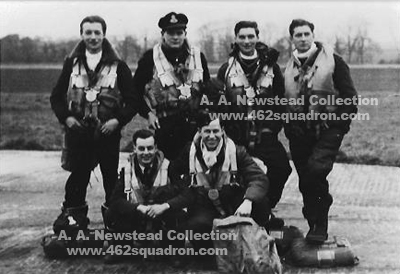
Photo from the A. A. Newstead collection.
Above: Six of the Anderson Crew in flying gear.
Back, left to right: F/Eng 'Duke' Newstead, with Eng. tool bag hanging by his right thigh,
Pilot 'Andy' Anderson,
MU/AG 'Aggie' Gordon, R/AG Fred Satherley.
Front left, Nav George Hicks;
right, W/Op 'Dinger' Bell, holding his W/Op equipment bag. |
Crew 45, 462 Squadron, Driffield, Yorkshire, and Foulsham, Norfolk
Pilot: Henry Robert ANDERSON (Andy) 428018 RAAF
Bomb Aimer: K J FAITHFULL (Ken or KJ) 1603341 RAF (VR?)
Navigator: George Frederick HICKS 1803292 RAF (VR?)
Wireless Operator: Bruce Alfred BELL (Dinger) 417941 RAAF
Mid-Upper Gunner: Astley GORDON (Aggie) 1819897 RAF (VR?)
Rear Gunner: F SATHERLEY (Fred) 1211556 RAF (VR?)
Flight Engineer: Arthur A NEWSTEAD (Duke) 1593580 RAF (VR?)
Special Duties: WINDOW Dispensers (Foulsham)
Special Duties: RCM (Foulsham)
Various reunion photos
Links to additional crew information; Flight Engineer Training;
Memories, True Stories,
and Crew Ops;
and loss of aircraft.
Reference sources – Australian WW2 Nominal Roll; The National Archives of Australia (RAAF Service Files; 462 Squadron Operational Record Book; Movement of 462 Squadron Series A2217), and 462 Squadron veterans as named in the text.
Special thanks must go to Duke Newstead for his photos on this page and throughout this website, and for information which he cheerfully supplied. Thanks also go to Duke and his Duchess for their hospitality when I visited them in 2012, during my travel around the UK.
|
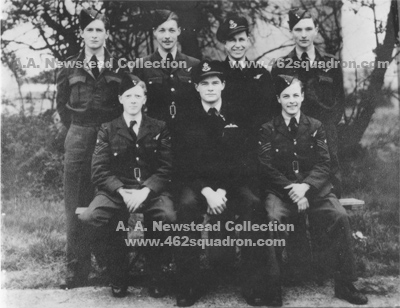
Photo from the A. A. Newstead collection.
|
Crew 45 at Foulsham, May 1945, on or about VE Day.
This is possibly the only photo ever taken of the complete crew.
During May 1945, four of the crew were posted from the Squadron.
Back, left to right:
R/AG Fred Satherley,
F/Eng 'Duke' Newstead,
W/Op Bruce Bell, RAAF,
MU/AG 'Aggie' Gordon.
Front left:
Bomb Aimer Ken Faithfull,
Front centre:
Pilot 'Andy' Anderson, RAAF,
Front right: Nav George Hicks.
This photo clearly shows the difference in the blue colours of the Air Force uniforms – Bell and Anderson wearing the darker blue of the RAAF, and the other five wearing the lighter blue of the RAF. Five are wearing "best blues" dress uniform, with belted coat. The 2 gunners are wearing "bomber jacket" work uniform.
On enlargement, the letters AG (including for the W/Op/AG), E, B and N are clearly visible in their half-wing brevets.
|
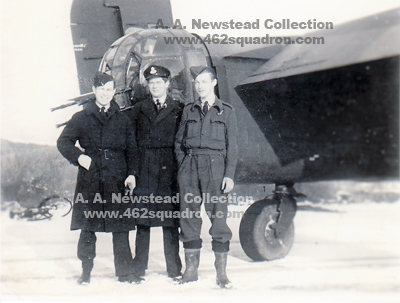
Photo from the A. A. Newstead collection.
Above: Three of the Anderson crew, at the rear turret of a Halifax,
winter 1944/1945
(with ubiquitous bicycle transport in background).
Left to right: W/Op Bell, Pilot Anderson,
F/Eng Newstead.
|
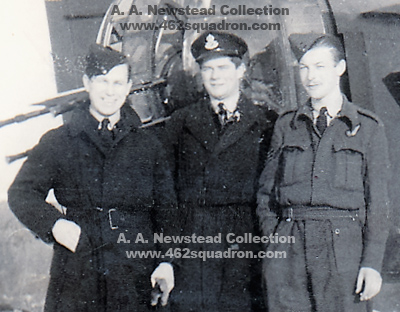
Photo from the A. A. Newstead collection.
Above: Closer view of the three crew members.
Left to right: W/Op Bell, Pilot Anderson,
F/Eng Newstead.
Return to top
|
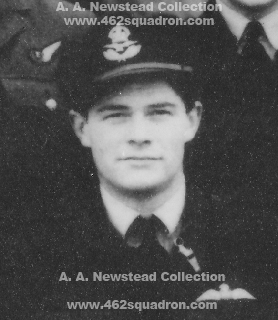
Photo from the A. A. Newstead collection.
Pilot 'Andy' Anderson, image cropped from the crew photo of May 1945.
|
Pilot
Name: Henry Robert ANDERSON (Andy)
Service: Royal Australian Air Force
Service Number: 428018
Date of Birth: 11 June 1924
Place of Birth: Ulverstone, Tasmania
Date of Enlistment: 11 September 1942
Place of Enlistment: Hobart, Tasmania
Next of Kin: George ANDERSON
Date of Discharge: 29 January 1946
Rank at Discharge: Flying Officer
Posting at Discharge: 9 Aircrew Holding Unit
Honours and Gallantry: Distinguished Flying Cross
Prisoner of War: No
Return to top
|
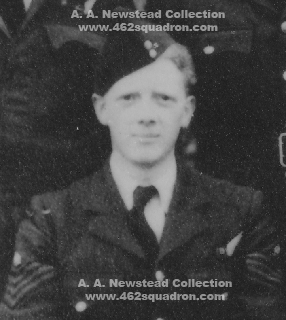
Photo from the A. A. Newstead collection.
Bomb Aimer, Ken Faithfull,
image cropped from the crew photo of May 1945.
|
Bomb Aimer
Name: K J FAITHFULL (Ken)
Service: Royal Air Force (Volunteer Reserve?)
Service Number: 1603341
Date of Birth: 29 March 1923
Place of Birth: .....
Date and Place of Enlistment: ..... *
Next of Kin: .....
Posting from 462 Squadron: May 1945
Rank at Posting from 462 Squadron: Flight Sergeant
Posting at Discharge: .....
Prisoner of War: No
* From the website http://www.ab-ix.co.uk/rfc_raf.pdf which details
RFC and RAF Service Numbers: No. 1600001 to No. 1610000 were allocated from September 1941 at Oxford. This batch includes 1603341 for Ken Faithfull.
Return to top
|
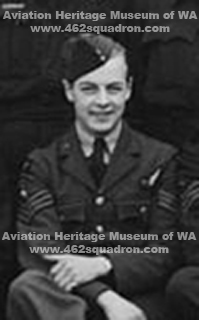
Photo from the Aviation Heritage Museum Collection
Navigator Flight Sergeant George Frederick Hicks, image cropped from the group photo of Navigators of 462 Squadron, Foulsham 1945.
|
Navigator
Name: George Frederick HICKS
Service: Royal Air Force (Volunteer Reserve?)
Service Number: 1803292
Date of Birth: .....
Place of Birth: .....
Date and Place of Enlistment: ..... *
Next of Kin: .....
Posting from 462 Squadron: May 1945
Rank at Posting from 462 Squadron: Flight Sergeant
Later Postings: Post-war career in the permanent RAF
Prisoner of War: No
* From the website http://www.ab-ix.co.uk/rfc_raf.pdf which details
RFC and RAF Service Numbers: No. 1800001 to No. 1814800 were allocated from December 1941 at Euston. This batch includes 1803292 for George Hicks.
Return to top
|
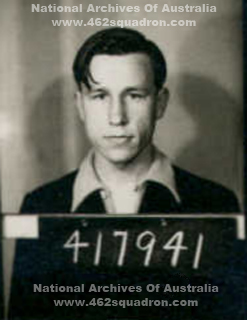
Photo from the National Archives of Australia: A9300, 417941
Bruce Alfred Bell, 417941 RAAF,
at enlistment on 15 August 1942, Adelaide.
|
Wireless Operator
Name: Bruce Alfred BELL (Dinger)
Service: Royal Australian Air Force
Service Number: 417941
Date of Birth: 24 July 1923
Place of Birth: Largs Bay, South Australia
Date of Enlistment: 15 August 1942
Place of Enlistment: Adelaide, SA
Next of Kin: Richard BELL
Date of Discharge: 14 December 1945
Rank at Discharge: Flying Officer
Posting at Discharge: 9 Aircrew Holding Unit
Prisoner of War: No |
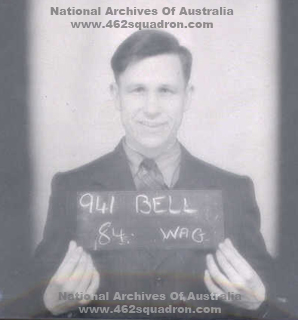
Photo from the National Archives of Australia: A9300, 417941
Bruce Alfred Bell, 417941 RAAF, under training as a
Wireless Air Gunner (Course 84, possibly late 1942).
|
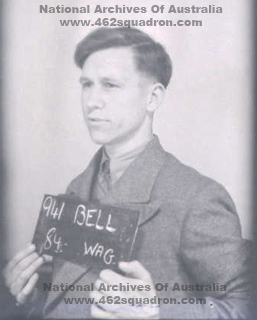
Photo from the National Archives of Australia: A9300, 417941
Bruce Alfred Bell, 417941 RAAF, under training as a
Wireless Air Gunner (Course 84, possibly late 1942).
|
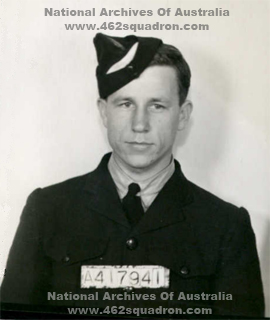
Photo from the National Archives of Australia: A9300, 417941
Aircraftman Bruce Alfred Bell, 417941 RAAF, August/September 1942. He was promoted to Leading Aircraftman on 10 October 1942.
|
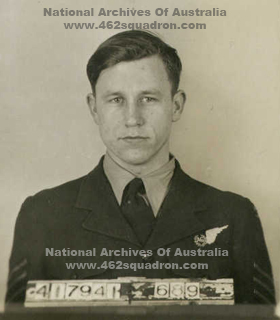
Photo from the National Archives of Australia: A9300, 417941
Sergeant Bruce Alfred Bell, 417941 RAAF. On 9 August 1943, he was awarded his Air Gunner's Badge, and promoted to Sergeant so this photo is after that date (AG brevet and Sgt stripes clearly visible).
Return to top
|
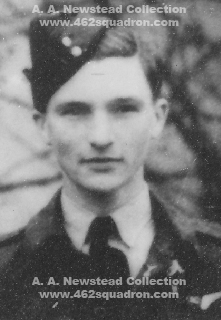
Photo from the A. A. Newstead collection.
Mid-Upper Gunner Aggie Gordon, image cropped from the crew photo of May 1945.
|
Mid-Upper Gunner
Name: Astley GORDON (Aggie)
Service: Royal Air Force (Volunteer Reserve?)
Service Number: 1819897
Date of Birth: 26 December 1924
Place of Birth: .....
Date and Place of Enlistment: ..... *
Next of Kin: .....
Posting from 462 Squadron: May 1945
Rank at Posting from 462 Squadron: Flight Sergeant
Posting at Discharge: .....
Prisoner of War: No
* From the website http://www.ab-ix.co.uk/rfc_raf.pdf which details
RFC and RAF Service Numbers: No. 1815001 to No. 1820000 were allocated from July 1942 at Birmingham. This batch includes 1819897 for Aggie Gordon.
Aggie Gordon may also be seen in the photo of Gunners of 'B' Flight, March 1945, on the 462 Squadron Foulsham page.
Return to top
|
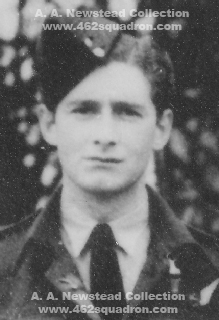
Photo from the A. A. Newstead collection.
Rear Gunner Fred Satherley, image cropped from the crew photo of May 1945.
|
Rear Gunner
Name: Fred SATHERLEY
Service: Royal Air Force (Volunteer Reserve?)
Service Number: 1211556
Date of Birth: .....
Place of Birth: .....
Date and Place of Enlistment: ..... *
Next of Kin: .....
Posting from 462 Squadron: ? 1945 (not listed in ORB)
Rank at Posting from 462 Squadron: ? Sgt (not in ORB)
(Sgt on last Op, May 1945)
Posting at Discharge: .....
Prisoner of War: No
* From the website http://www.ab-ix.co.uk/rfc_raf.pdf which details
RFC and RAF Service Numbers: No. 1150001 to No. 1250000 were allocated from April 1940 at Cardington. This batch includes 1211556 for Fred Satherley.
Fred Satherley may also be seen in the photo of Gunners of 'B' Flight, March 1945, on the 462 Squadron Foulsham page.
Return to top
|
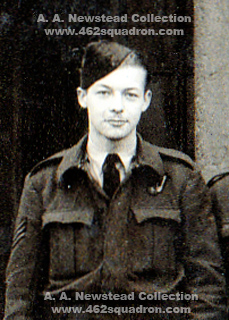
Photo from the A. A. Newstead collection.
Sgt Arthur A Newstead (Duke), Flight Engineer, 462 Squadron, November 1944. Image cropped from the group photo of Flight Engineers, 462 Squadron Driffield.
|
Flight Engineer
Name: Arthur A Newstead (Duke)
Service: Royal Air Force (Volunteer Reserve?)
Service Number: 1593580
Date of Birth: 09 August 1925
Place of Birth: County Durham, England
Date and Place of Enlistment: 22 November 1943 *
Next of Kin: .....
Date of Posting from 462 Squadron: September 1945
Rank at Posting from 462 Squadron: Sergeant
Posting at Discharge: .....
Prisoner of War: No
* From the website http://www.ab-ix.co.uk/rfc_raf.pdf which details
RFC and RAF Service Numbers: No. 1585001 to No. 1600000 were allocated from September 1941 at Weston-super-Mare. This batch includes 1593580 for Duke Newstead. However it appears that the Doncaster Attestation Centre in Yorkshire was issuing 159 series Service Numbers in 1943 for all entrants from the Northern Counties, i.e. Yorkshire, Durham, Northumberland in the east, and Cumberland and Westmorland in the west. F/Eng Newstead was from Durham, F/Eng Len Brocklesby (1594323) from Yorkshire, and F/Eng Geordie MacPherson (1590727) from Northumberland, all with 159 series Service Numbers. F/Eng Tom Walker (1590544) enlisted at Doncaster (December 1942). R/AG Denis Muxlow (1590607, Crew 29) of Spalding, also enlisted at Doncaster (January 1943).
|
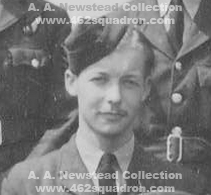
Photo from the A. A. Newstead collection.
Sgt Arthur A Newstead (Duke), Flight Engineer, 462 Squadron, June 1945. Image cropped from the group photo of Flight Engineers, 462 Squadron Foulsham.
Return to top
|
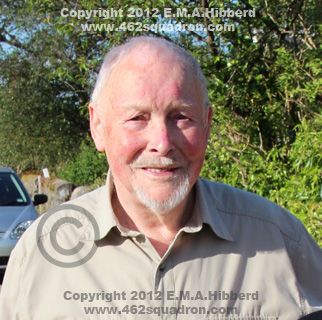
Copyright © 2012 E. M. A. Hibberd
Arthur A Newstead (Duke), former Flight Engineer 462 Squadron, when visited on 2nd June 2012.
|
Special Duties, WINDOW – Foulsham,
with this crew
J E A GRAY, 1595968 RAFVR
D HULBERT, 593796 RAF
T A CASTLE, 1862268 RAF (VR?)
G ROBINSON, 1595325 RAF (VR?)
J F LATIMER, 1551478 RAF (VR?)
A G TAYLOR, 423491 RAAF
W A QUYE, 1802290 RAF (VR?)
H W CALMAN, 423631 RAAF
J G LYNCH, 650438 RAF
W T PARKER, 1897610 RAF (VR?)
S E TILLS, 17596 RAAF
R G IRMINGER, 437308 RAAF
G FINK, 435339 RAAF
D B PATTERSON, 1827279 RAF (VR?)
J F WALL, 432918 RAAF
Return to top
|
Special Duties RCM – Foulsham,
with this crew
J H COHEN, J.43638 RCAF
J EPPLER R.180016 RCAF
E C REINKE, R.218397 RCAF
Return to top
|
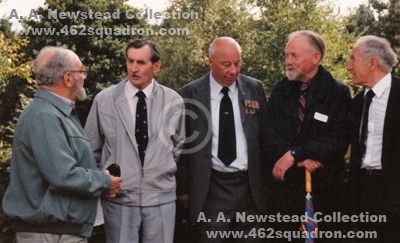
Photo from the A. A. Newstead collection.
The dedication and unveiling of Commemorative Plaques on the Foulsham Village Sign was held on Sunday 27 August 1989. Several former members of 462 Squadron attended. (More photos of this event are on the Robinson crew page, and the Foulsham Memorial page.)
Above, left to right:
J A Webber, Rear Gunner, Langworthy's Crew 34
Lyle David Robinson, Pilot, RAAF, crew 63
D R Smith, Rear Gunner, Scharer's crew 54
Duke Newstead, Flight Engineer, Anderson's crew 45
L G Brocklesby (Len), Flight Engineer, Marchant's crew 32
|
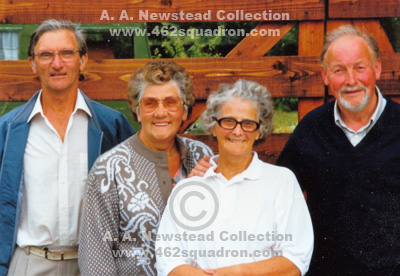
Photo from the A. A. Newstead collection.
Left to right: Astley (Aggie) and Betty Gordon, and Olive and Arthur (Duke) Newstead, Argyll, 21 June 1992.
This was the first meeting between between Mid-Upper Gunner Aggie, and Flight Engineer Duke, since the Anderson crew had been split up in May 1945. (Refer also comments in later section.)
|
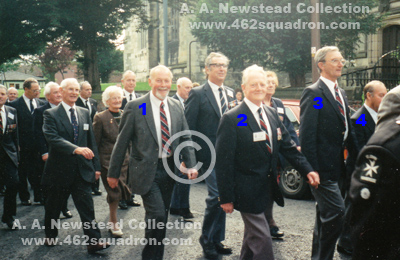
Photo from the A. A. Newstead collection.
Four members of 462 Squadron Crew 45 during the march to the unveiling of the Driffield Memorial on 12 September 1993.
As marked in blue numbers:- 1. F/Eng Arthur Newstead; 2. B/Aimer Ken Faithfull; 3. M/U Gunner Aggie Gordon; and 4. Nav George Hicks (partly obscured). This was the only crew with four members present on that day. Rear Gunner Fred Satherley was living in Spain at the time, and Pilot Anderson and W/Op Bell lived in Australia.
Other members of 466 and 462 Squadrons, and personnel of RAF Driffield who also marched were not identified in this photo. If you can assist with identification, please make contact.
|
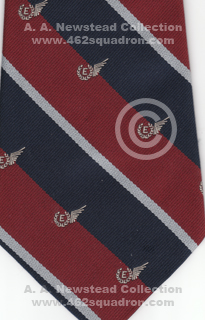
Photo from the A. A. Newstead collection.
RAF Flight Engineer's tie as worn by Arthur "Duke" Newstead in the march to the Driffield Memorial. All four members of this crew were wearing RAF ties. Ken Faithfull's tie was the standard RAF maroon/light blue/dark blue diagonal stripe, as was George Hick's tie. Duke Newstead and Aggie Gordon were wearing similar ties, but with the relevant Flying Brevet added – as above for the Flight Engineer, but with AG for Air Gunner.
|
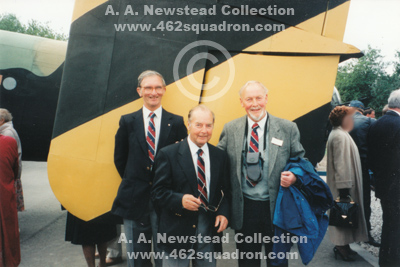
Photo from the A. A. Newstead collection.
At the Yorkshire Air Museum, Elvington on a significant date –
Friday 13th September 1996, L to R:
MU/AG
Astley Gordon, Navigator George Hicks, and Flight Engineer Arthur Newstead.
Bomb Aimer Ken Faithfull and his wife Betty had planned to attend, but family events prevented this.
In these two Elvington photos (similar to the previous photo at Driffield 1993), Gordon and Newstead are wearing their RAF ties with the relevant brevet (AG and E). Hicks is wearing a standard RAF tie.
The diagonal yellow-striped tailplane markings are for 158 Squadron (Number 4 Group) which was based at Lissett, Yorkshire.
|
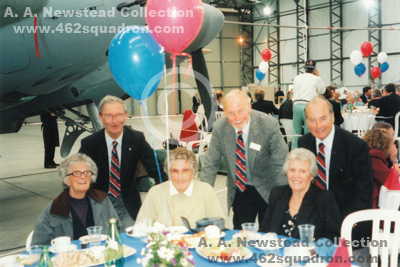
Photo from the A. A. Newstead collection.
Seated, L to R — Olive Newstead, Betty Gordon, Roz Hicks
Standing, L to R. Aggie Gordon, Duke Newstead, George Hicks
Notes from Duke ........
The location: Yorkshire Air Museum, Elvington
The event: the Roll out of Halifax "Friday the 13th"
LV907 NP-F 158 Squadron
The date: Friday 13th September 1996
The party: "Only those (and family), who had flown in Halifaxes were invited to the party. Lots of Halifax crew members attended from 4 Group and 6 Group. Everyone was very pleased to see and clamber aboard the old kite again, heaps of nostalgia even though the inside of the kite was unfinished and Aggie reported that the guns were wooden mockups."
Return to top
|
Additional crew Information
Postings and Rank – sourced from the 462 Squadron ORB
06 November 1944 – Crew Posted to 462 Squadron, Driffield; P/O Anderson, F/Sgt Bell; Sgts Faithfull, Hicks, Satherley, Gordon and Newstead. Crew names listed in ORB for November 1944; exact date from the RAAF Service Files of W/Op Bell and Pilot Anderson.
8/9/10 November 1944 – group photo of the Flight Engineers at Driffield. As advised by Flight Engineer Newstead .... "the crew had only been posted to Driffield a couple of days or so, before the photo was taken."
29 December 1944 – 462 Squadron relocated from Driffield (4 Group) to Foulsham (100 Group).
In the Proposed plan for relocation, Anderson and all of his usual crew were assigned to fly in Halifax Z5-Z, one of 23 aircraft and crews in the AIR PARTY (according to the Movement Order No. 1, dated 19 December, 1944). This Movement Order listed the 23 aircraft by “Z5-Letter” and the crews for each aircraft were listed by Service Number, Rank, Initials and Surname.
From F/Eng Newstead (and his logbook) ………. “We may have been assigned, but we did not fly as a crew in Z5-Z to Foulsham. Andy (Pilot Anderson) and Fred (R/AG Satherley) drove our wee Austin 7 car to Norfolk, and I flew as Flight Engineer with Flight Commander S/L Brophy in Z-Zebra on 29 December. As a sprog engineer, flying with the Flight Commander is not something you forget. Actually we got on very well together – but it was a very short flight. We always called the aircraft by its designation letter using the WW2 Phonetic Alphabet – e.g. A-Able, B-Baker, C-Charlie, etc. Not sure how Nav Hicks, B/Aimer Faithfull, MU/AG Gordon or W/Op Bell travelled to Foulsham, but I think that they flew.”
F/Eng Newstead's logbook entry for 29 December records the aircraft Z-Zebra, flight duration of ¾ hour, Pilot S/Ldr Brophy.
Also according to Movement Order No. 1, S/Ldr Brophy was to have proceeded with the Main Party by rail on 29 December. However, as advised by F/Eng Newstead, the plan had obviously changed by the departure date. The ORB for December 1944 recorded that "twenty aircraft" flew to Foulsham on 29 December, with "A" Flight Commander, S/Ldr J T Brophy in charge of the flight. On 30 December "three aircraft, the remainder of the Air Party", flew to RAF Station Foulsham.
However, the ORB does not record details of which aircraft were in each group. Nor does it record the personnel changes.
May 1945 – F/Sgts Faithfull, Hicks, and Gordon Posted FROM 462 Squadron, Foulsham, as recorded in the ORB.
September 1945 – F/O Anderson and F/O Bell Posted FROM 462 Squadron, Foulsham, with the dates for Anderson and Bell from their RAAF Service Files recorded as 17 September 1945; Flight Engineer Sgt Newstead on 22 September 1945.
Satherley's name was not included in ORB postings FROM the Squadron at any time, but, as personally advised by Newstead, R/AG Satherley was posted out in May 1945 with MU/AG Gordon.
Summary of Crew formation and history, with reference the RAAF Service Files of Bruce Alfred BELL, and Henry Robert ANDERSON (from National Archives of Australia)
| |
Bruce Alfred Bell |
Pilot Anderson |
RAF crew members |
| Enlisted RAAF |
15 August 1942, Adelaide, SA |
11 Sept 1942, Hobart, Tas |
|
| Training in Australia |
4 ITS |
1 ITS |
|
| Embarked for Canada |
02 November 1942, from Melbourne |
|
|
| Training in Canada |
2 WS, 2 BAGS, 2 AOS |
|
|
| Qualified |
Air Gunner Badge, 09 August 1943, promoted to Sgt |
Flying Badge, 01 July 1943, promoted to Sgt |
|
| Embarked for the UK |
From Canada, 14 February 1944 |
From Adelaide SA, 04 Aug 1943 |
|
| 11 PDRC, Brighton |
24 February 1944 |
11 Sep 1943 |
|
| Training UK |
2 (O) AFU, 18 April 1944 |
6 (P) AFU, 21 Mar 1944;
1516 BAT Flight, 25 Apr 1944 |
|
| 21 OTU, Moreton-in-Marsh |
06 June 1944 |
06 June 1944 |
|
| Commissioned |
Granted a Commission, rank of
Pilot Officer effective 18 Sept 1944 |
Granted a Commission, rank of
Pilot Officer effective 19 Sept 1944 |
|
| 61 Base, Aircrew School |
06 September 1944 |
06 September 1944 |
|
| 61 Base, 1659 HCU, Topcliffe |
14 September 1944 |
14 September 1944 |
F/Eng Newstead joined crew |
| 462 Squadron |
06 November 1944 |
06 November 1944 |
06 November 1944 (all of crew) |
| Promotion |
Flying Officer, 18 March 1945 |
|
|
| 9 ACHU, Gamston |
17 September 1945 |
17 September 1945, with group of RAAF officers |
22 September 1945, Newstead to RAF Bruntingthorpe |
| Embarked from UK |
20 September 1945 |
28 Oct 1945 |
|
| Disembarked from UK |
Perth, 29 October 1945 |
28 Nov 1945 |
|
| Discharged in Aus |
14 December 1945 |
29 January 1946 |
|
From the bold font entries in the table above:-
The initial crew of 6 formed at 21 OTU, Moreton-in-Marsh, probably on or soon after the 06 June 1944.
The flight engineer joined the crew at 1659 HCU Topcliffe, probably on or soon after 14 September 1944.
The crew of seven was posted TO 462 Squadron, Driffield on 06 November 1944, relocating with the Squadron to Foulsham on 29 December 1944.
According to the 462 Squadron ORB, the two RAAF crew members, Anderson and Bell, were posted FROM the Squadron TO 9 Aircrew Holding Unit at RAF Gamston on 17 September 1945, prior to repatriation to Australia. Anderson's and Bell's RAAF Service Files also both record this posting as 17 September 1945. However they may (must ?) have been "Attached" elsewhere from early May until September –- as noted in F/Eng Newstead's comments in a later section, they were both already gone when he returned from leave in May, and he had no further contact with them. Surely if they had also been at RAF Foulsham, they would have crossed paths.
Four of the RAF members of the crew were posted from 462 Squadron in May 1945.
The remaining Flight Engineers, including F/Eng Newstead, were posted as a group from 462 Squadron, Foulsham, to RAF Bruntingthorpe on 22 September 1945.
Return to top
Pilot Henry Robert ANDERSON 428018 RAAF – A9300 Service File, sourced from the National Archives of Australia.
Some events, as recorded on different documents, have different dates, varying from 1 day to over a week. The earlier date may refer to the actual date of Posting, and the later date for the same event may be the date of arrival at the new posting place, with a leave interval in between. Comments by this website's owner/author are in bracketed italics.
No Leave Forms have been retained in the Service File, so gaps in time-lines have not been accounted for.
Full description of some abbreviations have not yet been determined. If you can assist, please make CONTACT.
Air Training Corps (ATC)
19 Feb 1942 – Enrolled as Cadet 40065, at 6 Cadet Wing HQ, ATC, Hobart; aged 17, DoB 11/06/1924; nationality British; Next-of-Kin parent G M ANDERSON of 13 High St, Launceston, Tasmania.
19 Feb 1942 – Posted to 84 Squadron at 6 Cadet Wing, Launceston.
19 Feb 1942 – Commenced Preliminary Training as Cadet at 6 Wing; result PASS
21 May 1942 – Promoted to Corporal
01 Jun 1942 – Promoted to Sergeant
13 Aug 1942 – Commenced Training in “Stages of Syllabus” at 6 Wing; result PASS
11 Sep 1942 – Termination of enrolment in ATC, at rank of sergeant; for enlistment in the Citizen Air Force
Air Force
14 Jul 1942 – Application, Sworn and signed, to enlist in the CAF (Citizen Air Force); medical examination on same
date; height 5 ft 11 ¼ inches; weight 166 lb (11 st 12 lb = 75.3 kg); vision 6/6 both eyes; medium
complexion, blue eyes, dark brown hair; scar on left knee. Medical Category A1B, A3B.
11 Sep 1942 – Enlisted in CAF (Citizen Air Force) at 6 Recruiting Centre, RAAF, Hobart, Tasmania, as AIRMAN
PILOT, for Duration of War and 12 Months thereafter; age 18 y 3 m; date of birth 11 June 1924; Single; religion Presbyterian; British subject; Civil occupation Clerk; no civil convictions; no previous service with, or discharge or rejection from any defence Force; Education to Tasmanian Associated Public School Certificate; Next-of-Kin Mr George Neville Gibson ANDERSON (father), address “Shirley”, Lemana Junction, Tasmania; address changed to “Harehope”,
Gawler, via Ulverstone, Tasmania on 30 Sep 1942. (Unable to produce a positive image from the badly deteriorated film negative, taken at Enlistment.)
11 Sep 1942 – Classified as Air Craftman 2 (AC2), mustered as Air Crew V
11 Sep 1942 – Posted to 1 Initial Training School (1 ITS), Somers, Victoria
11 Sep 1942 – Commenced ITS Flying Course at 1 ITS
03 Nov 1942 – Re-mustered as Air Crew V (P)
05 Dec 1942 – Re-mustered as Air Crew II (P)
05 Dec 1942 – Promoted to Leading Aircraftman (LAC)
09 Dec 1942 – Completed ITS Flying Course at 1 ITS – result PASS
10 Dec 1942 – Posted to 7 Elementary Flying Training School (7 EFTS), Western Junction, Tasmania (near Launceston Airport; posting also recorded as 08 Dec 1942)
10 Dec 1942 – Commenced EFTS Flying Course at 7 EFTS
12 Dec 1942 – Hospitalised at Launceston General Hospital, until 17 Dec 1942 (details not recorded)
12 Feb 1943 – Completed EFTS Flying Course at 7 EFTS – result PASS
13 Feb 1943 – Posted to 7 Service Flying Training School, Deniliquin, New South Wales
16 Mar 1943 – Commenced SFTS / ITS Flying Course at 7 SFTS (Initial Training)
05 May 1943 – Completed SFTS / ITS Flying Course at 7 SFTS – result PASS
11 May 1943 – Commenced SFTS / ATS Flying Course at 7 SFTS (Advanced Training)
01 Jul 1943 – Completed SFTS / ATS Flying Course at 7 SFTS – result PASS
01 Jul 1943 – Awarded Flying Badge at 7 SFTS
01 Jul 1943 – Promoted to Sergeant at 7 SFTS
01 Jul 1943 – Re-mustered as Airman Pilot
02 Jul 1943 – Posted to 1 Embarkation Depot, Ascot Vale, Victoria (or 15/02/7/43)
04 Aug 1943 – Embarked by ship from Adelaide, South Australia
04 Aug 1943 – Attached to RAF, UK
10 Sep 1943 – Disembarked in UK
11 Sep 1943 – Posted to 11 Personnel Despatch and Reception Centre (11 PDRC), Brighton, UK
12 Sep 1943 – Admitted to CSQ (Centre Sick Quarters ?), 11 PDRC, Brighton, until 15 Sep 1943 (details not recorded)
13 Oct 1943 – Attached to 50 Group Pool, until 12 Nov 1943
19 Dec 1943 – Admitted to CSQ, 11 PDRC, Brighton; Casualty Report 358 UK – on seriously ill list
19 Dec 1943 – Transferred to Brighton Isolation Hospital
24 Dec 1943 – Casualty Report 362 UK – removed from seriously ill list.
ANDERSON was a patient at Brighton Isolation Hospital, UK, from 19 Dec 1943 until 01 Jan 1944. (No other details are recorded, however there is a separate "A705 CAsualty File" for him at the NAtional Archives of Aus – file dated 19 Dec 1943, Brighton Hospital, UK – but the file was not digitised as of 05 June 2022.)
01 Jan 1944 – Promoted to Flight Sergeant, at 11 PDRC
08 Feb 1944 – Attached to 1 A C D, until 06 Mar 1944 (unit and location not identified)
19 Feb 1944 – Medical Examination
21 Mar 1944 – Posted to 6 (Pilot) Advanced Flying Unit (6 (P) AFU) – RAF Little Rissington, Gloucestershire (?)
25 (or 26) Apr 1944 – Attached to 1516 BAT Flight (Beam Approach Training Flight) – Pershore, Worcestershire (?)
26 Apr 1944 – Commenced BAT Course, at 1516 BAT Flight
01 May 1944 – Completed BAT Course
02 May 1944 – Ceased Attachment to 1516 BAT Flight
06 Jun 1944 – Posted to 21 Operational Training Unit (21 OTU), Moreton-in-Marsh – for Operational Training in Wellington aircraft, and formation of crew – same posting date as W/Op BELL
06 Sep 1944 – Attached to Aircrew School, Dalton, until 14 Sep 1944
06 Sep 1944 – Posted to 61 (RCAF) Base – same posting date as W/Op BELL
14 Sep 1944 – Posted to 1659 Heavy Conversion Unit (1659 HCU), Topcliffe – for conversion to 4-engine Halifax bombers, and addition of Flight Engineer to crew.
19 Sep 1944 – Promoted from rank of Flight Sergeant to Probationary Pilot Officer
14 Nov 1944 – Discharged from RAAF, on being Granted a Commission (date seems to be out of logical sequence, or paperwork was delayed?)
15 Nov 1944 – Promoted to rank of Acting Flying Officer
06 Nov 1944 – Posted to 462 Squadron, Driffield, 4 Group – same posting date at W/Op BELL
16 Nov 1944 – First Op for ANDERSON as 2 nd Pilot for SANDERSON Crew 27
30 Nov 1944 – Second Op for ANDERSON with his usual crew
Please refer Ops Table in later section, for details of Crew Ops.
29 Dec 1944 – Crew relocated with 462 Squadron, Foulsham, 100 Group from Driffield
19 Mar 1945 – Promoted to confirmed rank of Flying Officer (this links with promotion to rank of P/O six months prior)
14 Apr 1945 – Forced landing at Liege, Belgium – details in later section
20 Jun 1945 – Attached to 3 Flying Instructors' School (3 FIS); 84 OTU Staff P Course; at Desborough ?, Wellington Bombers
17 Jul 1945 – to 21 Jul 1945 – Completed Flying Instructor’s Course
(No further postings listed between Jul and Sep 1945, and no leave forms in Service File – was he an Instructor at 84 OTU ?)
17 Sep 1945 – Posted to 9 ACHU (Gamston, UK) for repatriation to Australia
28 Oct 1945 – Embarked from Southampton, UK, in “Aquitania”
16 Nov 1945 – Award of Distinguished Flying Cross
28 Nov 1945 – Ceased Attachment to RAF, UK
28 Nov 1945 – Disembarked at Sydney
28 Nov 1945 – Posted to 2 Personnel Depot (2 PD), Bradfield Park, Sydney
12 Jan 1946 – Posted to 1 PD, Ransford, Melbourne
13 Jan 1946 – Posted to 6 PD, Hobart
29 Jan 1946 – Appointment terminated, at Rank of Flying Officer, on demobilisation from RAAF; Home address
Gawler, Tasmania
Pilot ANDERSON's Flying Hours – RAAF Form P/P 150, completed at 9 ACHU, before repatriation to Australia
Flying Training in Australia, and Aircraft flown –
7 EFTS – DH82A – 62 hours;
7 SFTS – Wirraway 104 h 50 m
Advanced Flying Training UK, and Aircraft flown –
6 (P) AFU – Oxford – 84 h 55 m
21 O T U – Wellington – 77 h 05 m
1659 HCU – Halifax II & V – 43 h 25 m
18 EFTS – DH82A – 18 h 30 m
462 Sqn – Halifax III – 76 h 30 m
F I S Course at 3 F I S (UK) – Oxford – 40 h 15 m
Operational Flying from 15 Nov 1944 to 02 May 1945 –
462 Sqdn – Bomber – Halifax III – 23 Ops;
1st Pilot – 121 h 25 m;
2nd Pilot – 5 h 20 m
Total Flying – 634 h 15 m (checked and mathematically correct)
Medals – 1939-45 Star, France and Germany Star, Defence Medal; eligible for Returned from Active Service
Badge.
Decoration – Distinguished Flying Cross; a blurred carbon copy of the full citation is included in ANDERSON's Service File; and has been fully transcribed, as below .......... (Note that the citation refers to the "other starboard engine", however the event as written by F/Eng NEWSTEAD describes to loss of both port engines – see later section.)
ROYAL AUSTRALIAN AIR FORCE
HONOURS AND AWARDS
DISTINGUISHED FLYING CROSS
FLYING OFFICER HENRY ROBERT ANDERSON (428018)
CITATION:
Flying Officer ANDERSON as pilot and captain
of aircraft has attacked some of the most heavily defended
targets in Europe.
In April, 1945, he was detailed to attack
the Potsdam air-field and shortly before reaching the target
the engine of his aircraft failed, but undaunted he continued
the run and bombed the target accurately, despite heavy
enemy opposition.
Whilst still in the target area, the other
starboard engine failed, but nevertheless, Flying Officer
Anderson flew back to allied territory where he made a
forced landing.
At all times, this officer has displayed
fine courage and devotion to duty.
Private Address: “Harehope” Gawler via ULVERSTONE, Tasmania.
Honours and Gallantry Awards (sourced from the London Gazette)
Henry Robert Anderson – Award of Distinguished Flying Cross
London Gazette, Issue 37352, Tues 13 Nov 1945, 4th Supplement Fri 16 Nov 1945, page 5592
Air Ministry, 16 November 1945
The KING has been graciously pleased to approve the following awards .....
ROYAL AUSTRALIAN AIR FORCE .....
Distinguished Flying Cross
Flying Officers .....
Henry Robert ANDERSON, (Aus.428018) 462 (R.A.A.F.) Sqn., effective 13 August 1943
Also published in the Commonwealth of Australian Gazette on 06 December 1945, page 2613, position 18.
The DFC Card at the Australian War Memorial (copy below), records that Flying Officer Henry Robert Anderson, 428018 RAAF, of "Harehope", Gawler, Via Ulverstone, Tasmania, was presented with his Distinguished Flying Cross by The Governor of Tasmania, at Government House on 07 May 1947.
The Citation reads ..... "Fine courage as Pilot in attacks on targets in Europe".
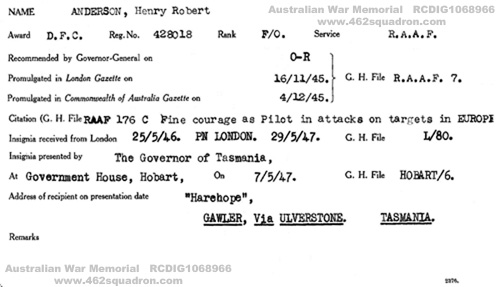
Australian War Memorial, ref RCDIG1068966
24 May 1951 – Signed Application Enrolment in the Air Force Reserve, (General Reserve) at Melbourne, Vic;
previous Service as F/O Henry Robert ANDERSON, DFC, 428018, Pilot; no currently in any Armed Service; no
known disability; current profession as Hire Car Operator; Marries; residence at “Ardoloney” Macedon Road,
Sunbury; Stamped & initialled “OK 10/7” and Medical “OK 15/8”.
Dec 1978 – Application to Dept of Veterans’ Affairs for “Statement of Service for WW2” – address then c/-
Westpac Bank, cnr Queen & George Sts, Brisbane
(End of Pilot ANDERSON's File) Return to top
Wireless Operator Bruce Alfred BELL 417941 RAAF – Nick named in Crew as “Dinger”.
Information extracted from his A9300 Service File, digitised by the National Archives of Australia.
Photos – at enlistment, and during training – please see previous section.
20 January 1942 – Enrolled in the RAAF Reserve, at 5 Recruiting Centre (5 RC), Adelaide, South Australia; aged 18
yr 5 mths; dob 24 July 1923, born at Largs Bay, SA; Single, British Subject, religion Church Of England; No previous
defence Force service; No civilian convictions; civil occupation as “Inspector on Aircraft” at Woodvillle, SA;
residence at Glanville, SA. Height 5 ft 7½ inches (171.45 cm); weight 133 lb (9 st 7 lb; 60.3 kg); chest 31/34 inches;
vision 6/6 both eyes, Ishihara colour vision test – Normal; heating 20/20 both ears; medium complexion, blue
eyes, brown hair; no vac marks; small scars on 2 left fingers; Medical Classification A1B, A3B; Oath taken and
signed on 20 Jan 1942. Allocated Reserve Number 2966.
15 August 1942 – Enlisted in the RAAF Citizen Air Force at 5 RC Adelaide, SA, for the Durations of the War and 12
months thereafter; age 19 yrs; all other details as per the RAAF Reserve Enrolment on 20 Jan 1942; Oath taken
and signed on 15 Aug 1942. Next of Kin – Richard BELL, father, of same address; additional person to be informed
in event of casualty – Mrs B O’Neill, sister of Rosewater Gardens, SA. [Later forms had the Additional Person listed
as Miss D Bayley of Adelaide, SA, relationship not recorded]
Education at Ethelton Public School, Glanville SA; Le Fevre Technical School, Port Adelaide SA; Intermediate
Examination through Uni of Adelaide
15 August 1942 – Allocated Service Number 417974
15 August 1942 – Classified as AC2; Mustered as Aircrew V
15 August 1942 – Posted to 4 Initial Training School (4 ITS), Victor Harbour, SA; attended Aircrew Course 31 (G)
until 09 Oct 1942, Pass result
05 Oct 1942 – Re-mustered as Air Crew V (G)
08 Oct 1942 – Report on Character and Trade Proficiency – Character Very Good, under Training at rank of AC2
10 Oct 1942 – Reclassified as LAC
10 Oct 1942 – Posted to 2 Embarkation Depot (2 ED) Bradfield Park, NSW
31 Oct 1942 – Posted to 1 ED, Ascot Vale, Victoria
02 Nov 1942 – Attached to RCAF (until 13 Feb 1944)
02 Nov 1942 – Embarked from Melbourne, Vic, for Canada
27 Nov 1942 – Disembarked in Canada
27 Nov 1942 – Posted to 3 Manning Depot (3 MD), Edmonton, Alberta, Canada
04 (or 05) Dec 1942 – Posted to 2 Wireless School (2 WS) Calgary, Alberta, Canada (also recorded in file as W T S,
assume Wireless Telegraphy School); training in Fleet Fort II, and Norseman aircraft; 39 hours 10 Minutes flying
time
25 (or 26) Jun 1943 – Posted to 2 Bombing and Gunnery School (2 BAGS) Mossbank, Saskatchewan, Canada;
Course 58; training in Bolingbroke/Blenheim aircraft; 11 hours 50 min flying time
09 Aug 1943 – Awarded Air Gunner’s Badge
09 Aug 1943 – Re-mustered as WOAG
09 Aug 1943 – Promoted to T/Sergeant, WO/AG
12 (or 13) Aug 1943 – Posted to Air Observers School (2 AOS), Edmonton, Alberta, Canada; non-Operational
Flying/Instructional between 13 Aug 1943 and 24 Jan 1944, in Anson II and V aircraft, 284 Hours 35 Minutes
28 Jan 1944 – 7 days Embarkation leave, to 04 Feb 1944
03 (or 04) Feb 1944 – Posted to 1 “Y” Depot, Lachine, Quebec, Canada [also incorrectly recorded in file as 29 Feb 1944,
possibly in place of 29 Jan 1944?]
09 Feb 1944 – Promoted to T/Flight Sergeant
13 (or 14) Feb 1944 – Attached to RAF, until 29 Oct 1945
13 (or 14) Feb 1944 – Embarked from Canada [one form incorrectly lists this as Embarked from Aus]
24 Feb 1944 – Disembarked in UK
24 (or 25) Feb 1944 – Posted to 11 Personnel Despatch & Reception Centre (11 PDRC), Brighton, UK
11 Mar 1944 – Re-mustered as Wireless Operator (W/OP (AIR)), Gen Duties
18 April 1944 – Posted to 2 Advanced (O) Flying Unit (2 (O) AFU), Millom, Cumbria, UK; Course 278 W/AG; training
in Anson aircraft; 38 hours 50 min flying time
6 June 1944 – Posted to 21 Operational Training Unit (21 OTU), Moreton-in-Marsh, Gloucestershire, UK; training
in Wellington III and X aircraft; 77 hours 05 min flying time; formation of crew – same posting date as Pilot ANDERSON
29 Aug 1944 – 9 days leave, until 06 Sep 1944, at completion of training at 21 OTU.
Leave dates as listed for BELL from Sep 1944 until end of May 1945, have been included as they would
most likely coincide with leave dates for each other member of the crew.
06 Sept 1944 – Report on Character and Trade Proficiency – Character Very Good, under Training at rank of T/F/SGT, Mustering WOP/AG
06 Sept 1944 – Posted to Aircrew School, Dalton, 61 (RCAF) Base, until 14 Sep 1944; same posting date as Pilot ANDERSON
14 Sep 1944 – Posted to 1659 Heavy Conversion Unit (1659 HCU), Topcliffe, Yorkshire; training in Halifax II and V
aircraft; 45 hours 25 min flying time; addition of Flight Engineer to crew, same date of posting as Pilot ANDERSON (and Crew)
17 Sep 1944 – Report on Character and Trade Proficiency – Character Very Good, rank of T/F/SGT, Mustering WOP/AG; Proficiency Satisfactory for Skill in
Trade; Superior for Technical Warrant or Non-Comm Officer.
17 Sep 1944 – Discharged from RAAF pending receipt of Commission
18 Sept 1944 – Appointment to Commission, at Rank of Pilot Officer, General Duties
06 Nov 1944 – Posted to 462 Squadron, Driffield; flying in Halifax III aircraft; advanced training (Non-Op) 75 hours
55 min flying time; and Operational Flying 21 Ops, 118 Hours 20 Minutes, same date as Pilot ANDERSON (and Crew).
17 Nov 1944 – 7 days leave – to 23 Nov 1944
Crew Ops at 462 Squadron, are listed separately in a Table in a later Section.
BELL carried out 20 Ops as W/OP
with ANDERSON and Crew 45, plus 1 Op as WINDOW Dispenser with UTHER & Crew 26.
20 Dec 1944 – 7 days leave – to 26 Dec 1944
29 Dec 1944 – Relocated with 462 Squadron and Crew FROM Driffield (4 Group) to Foulsham, 100 Group
03 Feb 1945 – 7 days leave – to 09 Feb 1945
03 Mar 1945 – 7 days leave – to 09 Mar 1945
18 Mar 1945 – Promoted to rank of Flying Officer, General Duties
04 Apr 1945 – 9 days leave – to 13 Apr 1945
14 Apr 1945 – Forced landing at Liege, Belgium – please see later section for details of this event, and photo of
destroyed Halifax aircraft.
21 Apr 1945 – 7 days Survivor's Leave – to 27 Apr 1945 – most likely issued for all seven members of this crew, as well as
for 8th man for Special Duties RCM E C REINKE RCAF Service Number R.218397 (with variations).
29 May 1945 – 7 days leave plus 48 Hours VE leave – to 06 Jun 1945 – refer note by NEWSTEAD (in following section), that on his return from leave,
the 2 gunners were in the process of packing up, and they advised him that the Bomb Aimer and Nav had already been posted out, and the
RAAF Pilot ANDERSON and RAAF W/Op BELL had been repatriated (to Aus).
More Leave dates are listed for BELL later in 1945, but from the end of May, only the crew’s F/Eng NEWSTEAD
remained at Foulsham.
17 Sep 1945 – Posted to 9 Air Crew Holding Unit (9 ACHU), Gamston UK [It is not recorded in his Service File,
where he was posted to, or Attached to, or what his duties were, between the end of May 1945 and mid-Sept
1945. Was he with Pilot ANDERSON training for, or carrying out Instructional Duties? His Log Book may have the
answer.]
Undated Sep/Oct 1945 – Posted to 11 PDRC Brighton
Undated Sep/Oct 1945 – Embarked from England, for Australia in ship “Stirling Castle” (variously dated in file as
04 Sept, or 20 Sept, or 04 Oct 1945)
29 Oct 1945 – Disembarked at Perth, Western Australia
29 Oct 1945 – Posted to 5 PD Adelaide, SA, ex overseas service
09 Dec 1945 – Posted to 4 PD, Adelaide
14 Dec 1945 – Appointment terminated on demobilisation at 4 PD; payment in lieu of 82 Days Leave (28 days
Disembarkation Leave, 7 Days Recreation Leave, and 45 days War Service Leave)
07 Feb 1946 – Certificate 14231 for Service and Discharge as Officer issued after Demobilisation wef 14 Dec 1945
14 Feb 1946 – Certificate 11796A for Service and Discharge for Time as Airman
General Conduct Sheet – Certified No Entry for Aus & UK Postings
Service Conduct Sheet – Certified No Entry by RAF, UK
Flying Time
Training in Canada – 51 hours [2 BAGS, and 2 WTS]
Non-Op /Instructional Flying Canada – 284 hours 35 min [2 AOS]
Advanced Training UK – 237 hours 15 Minutes [2 (O) AFU, 21 O T U, 1659 HCU, 462 Sqdn]
Operational Flying UK (Driffield, Bombing; & Foulsham Bomber Support) – 118 hours 20 min [462 Squadron]
TOTAL Flying time – 691 Hours 10 min
Service Medals
1939-45 Star, France and Germany Star, Defence Medal, War Medal 1939-45, Australian Service Medal 1939-45,
Returned from Active Service Badge.
Bruce Alfred BELL (Dinger) died on 31 January 2016, at Largs North, South Australia, aged 92 years, as advised by his daughter Anne.
Return to top
Service details for A A "Duke" Newstead (as personally advised by him)
February 1943 – Applied to join the RAF under the Deferred Service Scheme; accepted for Flight Engineer training and allocated his Service Number 1593580 (then aged 17½ years).
22 November 1943 – Commenced training at ACRC London, aged 18¼ years. (No. 1 Air Crew Reception Centre was at Lords Cricket Ground at St. Johns Wood, London).
16 August 1944 – after having trained and qualified as a Flight Engineer at St Athan, Wales, received his "tapes and brevet", i.e. Sergeants stripes and Engineers half-wing brevet.
As described in crew summary above, he joined the crew at 1659 HCU Topcliffe, and was posted with them to 462 Squadron in early November 1944. Crew Ops are detailed in a later section.
Duke on "Escape photographs" – (in response to speculation on time and place for photographs of R/AG John Lynch in civilian clothes, of Ridgewell Crew 37) .....
"Perhaps they are his “Escape Photographs” probably taken at HCU. Aircrew were photographed in civilian clothes, the pictures printed out in passport photo size and carried by aircrew on ops. If a crewman bailed out, evaded capture, and made contact with one of the many Resistance movements on the Continent, the photographs would make it much easier for him to be provided with false identity papers. I recall that I carried mine on ops in an envelope fastened to one of my two Pandora’s boxes (Survival boxes) with stout rubber bands made from a discarded inner tube."
Duke's recollections of May 1945, and the break-up of the Anderson crew .....
"We all went on the usual week's leave in May '45 little knowing what the RAAF/RAF had planned for us. At the end of leave I returned to my dismal Nissen hut to find half the beds stripped, and the two gunners, Aggy Gordon and Fred Satherley packing their kit ready to depart. They explained that Ken Faithfull and George Hicks had already been posted out, and that Bruce Bell and Andy Anderson had been repatriated!! I was stunned. .... I remember a number of guys who I became friendly with in the absence of my crew but I have no recollection of ever seeing Andy or Dinger, yet we were on good terms, always. I remember doing some flying, swimming in a nearby farmer's pond, listening to Current Affairs talks, that busses were laid on to take any who fancied it to do "Dinghy Drill" on Cromer Beach, needless to say without a dinghy. ....... Although all the crew were in contact post-war we rarely talked about the war."
(See also the photo of the complete crew of seven, taken on or about VE Day at Foulsham.)
After posting from 462 Squadron to Bruntingthorpe with all of the remaining Flight Engineers in September 1945, Duke Newstead re-mustered to ground trade, retaining his "tapes". He then served the last 14 months of his Service in Italy – 10 months in Naples, and 4 months in Rome.
Circa March 1947 – Demobbed at RAF Ciampino, Rome; Duke "had a wonderful time in that unhappy but beautiful country".
When Aggy Gordon and Duke Newstead met up in June 1992, they had not seen each other since the crew had been split up and dispersed at the end of their leave in May 1945. At the reunion in 1992, Aggy presented Duke with a photo which he had been keeping safe for the last 47 years!
Apparently, as VE Day approached, Pilot Andy Anderson had visited a Studio to have a photograph taken of himself. He then endorsed each copy with a farewell message to each crew member. In May 1945 before he left the Squadron, he had given them out to the other crew members, except for Duke who was still on leave. Andy had given Aggy a copy of the photo to be passed on to Duke.
Duke remained in 462 Squadron until September 1945, and in the intervening time did not see or hear of Andy Anderson or Bruce Bell. If Anderson had remained at Foulsham, he would surely have delivered the photo to Duke himself.
Interestingly, Bruce Bell's RAAF Service File lists his official Posting from 462 Squadron as being on the 17 September. Anderson's Service File also lists his official Posting from 462 Squadron as 17 September. According to Anderson's file, he was "Attached" to 3 FIS for training for an Instructional Role. Perhaps Bell was also similarly "Attached" somewhere, but if so, it is not listed in his Service File. Whatever date they actually departed from Foulsham, their names were listed with Officers posted out in the September 1945 ORB, so perhaps the paperwork took a while to catch up.
(Many other personnel were listed in Postings TO the Squadron, but not in Postings FROM. Conversely, some were listed in Postings FROM, but there is no record of their Posting TO. However, there was a War on, so mistakes were made.)
Duke celebrated his 91st birthday with family in August 2016. He lives with his Duchess in a lovely part of the UK and is actively involved in his community. He is well versed in the use of computers, printers, scanners, and emails etc. (not bad for a Nonagenarian). In 2018 he donated his Foulsham Souvenir Mug, made for attendees of the 1989 Commemoration of the Foulsham Memorial. He is a regular contributor to this website – still going strong in 2019, his 94th year. Thank you, Duke.
June 2022 – Duke Newstead, aged 96, living in Scotland, is still making contributions to this website – thanks again, Duke.
August 2023 – Sad news from Scotland with the report of the death of Arthur Addison NEWSTEAD, also known as Duke NEWSTEAD. He died peacefully in his sleep during the night of 06/07 August 2023, just prior to his 98th Birthday. Duke was a regular contributor to this website, passing on his knowledge of life and events at 462 Squadron. It was a pleasure, and a privilege, and an honour to have known Duke. He will be sadly missed by all who knew him. Fly high, Old Friend.
Return to top
Flight Engineer Training
At the request of the 462 Squadron website – written by Sgt. Flight Engineer A.A. ("Duke") Newstead (published on 462squadron.com website 06 December 2022)
As the majority of Flight Engineers on your (this) website (with the exception of Desert Air Force) were direct entries and trained to a formal syllabus, I'll write about their training.
The need for “someone to assist the pilot” arose with the arrival of the 4-engined bomber and it seems that the first raid by one of them was by ill fated Short Stirlings on 10th Feb 1941. This raid is also noteworthy as each of the 3 aircraft carried an LAC designated “Engineer / AG” – he was probably a ground fitter. How this fits in with the 1940 ( ?) Directive that all aircrew would have the minimum rank of sergeant to protect them should they be captured, I do not know, although many strange things were discussed and implemented before Air Marshall Sir Arthur “Butch“ Harris took over Bomber Command (BC) in February 1942. There is some evidence that some of the early types of 4-engined jobs carried a second pilot, which was obviously very wasteful, and in 1942 BC officially dispensed with Co-Pilots.
Surprisingly the Engineers Brevet appears in 1942 and originally were F/E not E. Most of the people who qualified to wear either of these brevets were serving RAF personnel and it was not until July 1943 that it was decided to allow “direct entry's “ (DE) to be recruited for training as engineers.
A syllabus was quickly drawn up and as St Athan already had a Technical Training Wing which trained ground fitters etc., they took on the job. At peak, the Station had about 5000 trainees, only a small proportion being F/E's.
The course for DE's was for 6 months and many people are surprised that we were only airborne for a short flight, about 4 weeks into our training, to ensure that we were not airsick. One bod in our billet was airsick, was given another chance, still sick, and on told he would be discharged home he commenced crying, the first time I had ever seen a man cry.
So St Athan kept churning out we F/E's, 22000 in all, but in late 1944 it found that it could not cope, so the first few weeks of training were carried out at RAF Locking which I think was a Technical Training base. And so it continued until wars end, claiming to have trained Australians, New Zealanders, South Africans etc., but not Canadians as the RCAF by 1944 was training its own F/E's in Canada. One of my school friends, a Canadian, had an elder brother who was an F/E on Halifaxes (6 Group) but sadly he and all his crew were lost so I do not know where he trained.
Of the 22000 F/E's trained at St Athan, they claim that 10,000 died which seems a very high death rate to me but I have no way of checking it. It took approximately a year's training for a F/E to do his first Operation, that is, starting at ACRC in London, ITW at Bridlington, (then F/E training); HCU at Topcliffe, and on to Squadron.
I could write more but I'll spare you that. I have enjoyed the challenge of researching and writing this.
Thank you, Duke Newstead.
(Source Material; “The History of the Air Engineer “ by F/Lt DC Stringman;
On-Line account)
Return to top
Memories of life on a WW2 Bomber Squadron,
462 RAAF Squadron 4 Group & 100 Group
Written by Sgt. Flight Engineer A.A. ("Duke") Newstead (published on 462squadron.com website 06 May 2022)
PRELUDE TO A BOMBING OPERATION
When we read the Battle Order which is pinned up in both the Officer’s and Sergeant’s Mess
this morning we know how many and who is flying on operations tonight and which aircraft
we would use, but that was all. From now on no private ‘phone calls would be allowed in or
out of our RAF Station and a limited number of people would be allowed out – to use a
modern phrase it was in lockdown, all in the interest of security.
Later in the day we will attend Briefing and all will be revealed-target, route, weather etc,
then we will be fed the traditional meal of bacon and eggs in the Sergeants Mess.
The Locker Room where we change into our flying gear is full of smoke and noise. Locker
doors banging, toilets flushing, hum of voices, then in the sudden silence that sometimes
occurs in a noisy room a plaintive voice is heard, “Les, seen my flying socks?,” a second
voice, “Hanging on your locker door, you clot”, ......”Ta ..sorry Les". Some one with quite a
decent voice is singing “Cuddle up a little closer lovely mine”, a popular song of the time, he
is probably serenading one of his crew or even his Skipper – it did happen!
I take off my collar and tie, put on my white silk scarf which is not only comfortable
but my talisman, my good luck charm, bought for me by my younger sister when I qualified
as Aircrew. It, and my tatty rabbits foot and penny with a hole in it have kept me safe for
over 15 operations. I pull on my heavy sweater, button a false fur collar taken from my
flying suit, on to my battle dress top, check that my pockets are empty except for my Form
1250 – Identity Card (I am of course wearing my “dog tags” around my neck) and on with my
battle dress.
My pockets were not really empty. I had four or five cigarettes in an old cigarette case
of my Dad’s, which were for Andy and me when we were airborne. Most of we smokers, and
there were a lot of us, feel more relaxed after our cigarette, particularly Andy who had by far
the most stressful job in the whole crew. He was only 20 years old, surely one of the youngest
pilots in Bomber Command, young to be responsible for 8 lives and an aircraft. I think that
the Air Ministry acknowledged this by decreeing that the pilot was Captain of the aircraft
irrespective of his rank. So a Sergeant pilot could have a Flying Officer Navigator.
Incidentally neither Andy, Aggy (20) or I (19), were in those days classed as adults. Adulthood
commenced when one became 21 not 18 and as teenager's had not been invented I suppose
we were youths.
I slip my two Pandora’s Boxes inside my battle dress, they are made from a plastic
like material which I think is Perspex, and curved to fit close to the body. The contents are
designed to help anyone who has baled out and managed to evade capture. One contains silk
maps of all the continental countries, paper currency and a phrase card printed in six or seven
languages, identifying the bearer as an Allied airman and promising rewards if help is
forthcoming. A standing joke is that the first phrase on the card reads –
“I am a Allied airman. Please direct me to the nearest Gentleman’s Toilet – urgently”
………… I am unable to vouch for the truth of this.
The other box has useful practical items to help the Evadee such as a small razor and soap,
fishing tackle, water purifying tablets, a small collapsible water bottle, knife, Horlicks tablets
and so on . I have my escape photo graphs strapped to one of my boxes, these are passport
style photographs taken in civilian dress, useful should an Evadee make contact with one of
the many Resistance Movements operating on the continent and false identity documents are
required. I also have some WakeyWakey Tablets (Benzedrine ) just to keep me alert, if
necessary.
The RAF/RAAF looks after its own – especially as it costs a lot to train Aircrew – and apart
from carrying trouser buttons which doubled as compasses and other such devices we also
were provided with “Escape Flying Boots”. Unlike the original brown sheepskin boots these
were black, still calf length and lined, but if necessary the tops could be cut off (a small knife
was concealed in the boot) leaving a pair of apparently black civilian shoes, very useful if the
Evadee was attempting to masquerade as a civilian. I tried them but found that the sole was
stiff and unyielding and unsuitable for clambering about the aircraft in flight which is part of
an Engineers job so I reverted to the more flexible soled original sheepskin boots.
Most of us are almost ready now, just parachute harness and Mae West's (Life Jackets) to
slip on but two gunners wearing their silk/wool vests and inspired by the Long John
underpants they are wearing are sparring noisily with each other – just relieving the tension.
They will add a thick sweater and electrically heated body suit and possibly flying overalls
later – and they need it. I once went aft at 18000 feet to speak to Fred, our rear gunner and he
had a 5 inch beard of ice hanging from his oxygen mask but he still gave me a cheerful
thumbs up, ….and never needed counselling in later life!
Our Skipper rounds us up and we pick up our helmets and chutes and bags and head for the
entrance and the waiting transport. Three of us carry some sort of canvas bag. The
navigator’s is so large he looks as if he is going away for a month and the wireless op’s looks
like a door to door salesman’s, but the engineers’ tool bag is a cute little thing with tie tapes,
the sort of bag that would be home made for little girls to carry their gym kit to school in.
Considering that the Mk 3 Halifax has four hefty Hercules engines, carries 1806 gallons of
fuel, weighs 64000lbs and has a wing span of 105feet we Engineers carry a very modest tool
kit. Mine seemed to be mainly lengths wire of various thickness, cordage ditto, various
screwdrivers and spanners, a small torch (flashlight) which I often carried in the top of my
boot, my Boy Scout clasp knife and a hefty pair of pliers. Good to be prepared. I've also got
some bars of dark stuff that passes for chocolate, Horlicks tablets, boiled sweets and a large
brown paper bag of sandwiches which a kindly WAAF in the Sergeants Mess has prepared
for the Skipper and me.
Must not forget my clipboard and Form something or other (forgotten its number) on which I
recorded oil pressure, cylinder head temperature etc.etc at, I think half hourly intervals, also
my calculator made from cardboard – honestly – on which by rotating the centre cardboard ring
I was able to compute our fuel consumption.
I also have my side arm, a .38 Smith & Wesson M&P Revolver which I carry in my tool bag
rather in a holster which is the American style. Carrying a side arm on operations was not
compulsory, it was left to the individual and in our crew only the Skipper and I carried a
revolver.
When our bomb aimer saw me packing my revolver he leaned in close to me and said in a
stage Western voice “I do not think that you will need that tonight pardner, we are attacking
Dortmund not Dodge City.”
As we are a Bomber Support squadron we are carrying an extra crewman, always known as
the “spare bod”, a gunner from another crew whose job is to throw out “Window” – metallic
strip – in order to confuse the Enemy’s radar. He is with our two gunners, Fred our rear gunner
who in addition to his ‘chute is carrying a building brick, and Astley (Aggy) our Mid-upper
gunner who is carrying 3 or 4 rolls of newspapers under his arm. This is to enable them to
carry out their private operation, newspapers for our troops fighting below and bricks for the
enemy.
We climb aboard the 3 ton trucks to be driven out to our aircraft which are dispersed
about the airfield to minimise damage should we be attacked by the enemy. A typical Bomber
Command airfield would have two, possibly three, mile long concrete runways encircled by a
concrete track, the perimeter track, which had widely spaced concrete pads on the outside of
it as parking spaces for one aircraft. Simply known as Dispersal.
With three or four crews in the truck, the WAAF driver drives around the Peritrack,
stops at the first aircraft on her list, walks around to the back of the truck and bawls ”B-
Baker.” “That’s us” some one calls and 8 bodies clamber out and head for their aircraft. We
move on to the next aircraft and as they climb out their Skipper calls to Andy “Bet you a pint
I’m home before you”. “You're on “ replies Andy.”Tell you what ..” says the disembodied
voice but the words are lost as the truck moves on to Z-Zebra which is our “kite” as we called
our aircraft.
Our three ground crew are waiting for us by the tools of their trade, a 10/12 HP Austin
utility truck with canvas rear cover (known as a Tilly, from utility) and the ubiquitous trolley
accumulator (Trolleyack) which would be used to start our aircraft’s engines, rather than use
our internal batteries.
I think that we had some difficulty talking to our ground crew. Not that we did not like them,
or trust them, we trusted them implicitly, it was simply that we never really got to know
them. A short meeting as now to prepare for take off, but all of us intent on doing our own
job not chatting, air crews used differing air craft which meant different ground crews and
even if a crew used the same aircraft frequently, as we did with Z5-Z, it did not mean that we
got to know the hard working ground crews better. Sorry lads.
The ground crew have already removed the engine 's protective covers and the bits and bobs
holding the flaps, rudder and elevators securely in position, but we re-check, it is our
responsibility to do so. We check carefully, Engines ? 4 – Check. Wings? 2 – Check. Let's get
aboard. Once aboard we stow our 'chutes and settle in. Starting the engines is an early priority,
not only for the obvious reason that we can't get far without them but because they operate
generators, hydraulic pump, vacuum pump and other bit of equipment which need to be
operating so that turret controls, navigation equipment, instruments could be checked before
take off.
Andy would signal to the ground crew by word and gesture that we were ready to start the
engines, and for them to then stand clear. I would turn on the ignition and press the starter
button for the port outer engine, a couple of turns, a puff of exhaust smoke and she'd be
running and so on with the other three, I'd run them at 1000 revs to warm them up while
anxiously watching my instruments. While warming up various checks would be carried out,
my own would include checking the fuel system, an important part of the Engineer's
responsibility. The standard fuel load was 1805 gallons of 100 octane petrol carried in 12 self-
sealing wing tanks, with provision made for overload tanks to be fitted when necessary . The
tanks were used in a rotational system, partly for safety and partly to keep the aircraft
balanced. For “dicey” situations, take off, over the Target and landing four tanks would be in
use, each one feeding a separate engine, minimising the danger should we be hit by flak or
gunfire. And this is one of the things I'd check. Changing the fuel feed from one tank to
another kept the Flight Engineer quite active during flight.
We were experimenting with a new fuel tank safety system which had just come into use. As
the fuel in the tanks was used during flight the inert gas, Nitrogen was introduced to replace
the highly inflammable Oxygen which greatly reduced the chance of ignition. Unfortunately
we had teething problems, mainly leakage, but we were advised to switch it on as even a
small amount of Nitrogen was better than none. Just for the record I recall that the control tap
was amidships on the port side of the aircraft. I believe that “Nitrogen Purging“as it is now
called is mandatory on all commercial aircraft now.
I check my Very pistol cartridges. The Very pistol had a one inch smooth bore barrel and
fired flares from a cartridge similar to a shotgun cartridge. In the Halifax it was positioned in
the roof above the Engineer's position facing out and upwards. I would particularly check that
I had the correct “Colours of the Day”, shared by all Allied services, to identify us and also
the German Colours. It puzzled us as to how we knew the German Colours of the Day and it
was only some twenty years after war's end, when the work of Bletchley Park was made
public that we understood.
I would check the emergency portable oxygen bottles, situated in each crew position. They
were about the size, and looked like, the inner of a very large vacuum flask but were very
much heavier. Obviously for use should our main oxygen supply fail but by clipping on one
of these bottles we were free to roam rather than being tied to our position by the short
standard corrugated oxygen tube. I think it was the Engineer who used the portable bottles
most often as the fuel cocks were inconveniently situated on the rear of the main spar which
was about a couple of metres from his position. Clanking back to do a tank change with the
bottle around my neck I felt a bit like Dickens Marley's Ghost who was draped in chains. I
suppose it was not too bad really but we all moaned about it.
And then flying in a kite we had never flown in before I found that some unknown genius had
done the obvious and arranged for an extra length of tubing to be fitted into the circuit so it
was possible for the engineer to reach the fuel cocks without the need for the portable bottle.
Obviously this semi official modification was soon fitted to the majority of our kites, but the
portable bottles were still needed as our Elsan (chemical toilet) was sited way aft. When
moving away from our normal position in the aircraft the protocol was to keep the Skipper,
and other crew members informed as to what was happening. When the Engineer moved
back to change fuel tanks it was important that should anything happen to him, liking getting
killed, it was known to all which tank(s) were being drained and which tanks were being
brought into use. In our crew, M/U gunner Aggy had enough knowledge of the fuel system to
complete the fuel change and he was ideally situated as he was sitting almost above the fuel
cocks. Had anything happened to Aggy I would have taken over his turret. Thankfully it
never happened.
As I carried out these checks and others, I was in frequent contact with Andy regarding the
condition of the engines as we did not want to be a non-starter. It was the crews proud boast
that during the 21 Ops we flew together we never had a “Non Start” or “ Early Return”. If
certain specified faults occurred a pilot could abort take off or return to base without
incurring any penalty, although it's doubtful if the C.O. would be too pleased. Actually there
was little that the aircrew could do to prevent the faults which caused the Op to be abandoned,
it was largely dependant on the quality of work carried out by the ground crew which was of
a high standard – and luck.
All crews wanted to complete their “Tour “ of 30 Operations and if one of our engines
showed, for example just marginally correct, or even a fraction high, oil pressure I'd make
sure that the reading was steady, switch off my microphone, so that only Andy could hear
me, explain the situation and suggest we press on. He always agreed and we always got away
with it. The confidence and impudence of youth.
Worth mentioning that Andy was awarded a “non immediate“ DFC – Distinguished Flying
Cross – in November 1945, the citation read “ Fine courage as pilot in attacks on targets in
Europe”. As a non immediate award was given, not for a specific act of valour which
warranted an immediate award, but for a general “Good Show “it was universally accepted
that the crew shared in the award. As the wit in the crew, KJ, put it “ Fella's we each have 1/7
of a DFC .” We considered that our good record concerning non starts and early returns
contributed to Andy's award. Still on the subject of medals, in both WW1 and WW2 class
distinction existed in the issue of Gongs (Medals). Let's take the Dam Busters crews as an
example. Most of the crews were exceptionally brave but when immediate bravery awards
were made the Officers in a crew would receive DFC's but the NCO's in the same crew
DFM's (Distinguished Flying Medals ) I think it was in the 1990's when a more egalitarian
system was introduced in the UK and everyone regardless of rank, receives a Cross. Not
before time!
Right, lets get back to our aircraft, which you will remember was still parked in dispersal
while the crew carried out their pre-flight checks. Things are progressing here, one by one the
crew were calling in their “OK, here Skip “and the three crewmen from the “Front Office “
plus the Mid Upper gunner would have moved into the Crash Position which was the the
internal space between the two hefty duraluminium beams which supported the wings. This
was a mandatory requirement on a Halifax when landing and taking off.
We worked to a tight time schedule and Andy is chivvying everyone along. He signals to the
ground crew corporal who comes aboard the aircraft with the Form 700 for Andy to sign. The
Form 700 is actually the aircraft's maintenance schedule and the Skipper signs to
acknowledge that he is accepting the aircraft in good condition. Naturally. The corporal heads
for the door to calls of “Will you shut the door after you Please?” – the old jokes are the best.
Corporal laughs and slams down the door. I move into the Second Dickey seat next to Andy,
as I strap myself in, Andy signals “Chocks away!” to the ground crew. I feel my stomach
muscles tighten and a rush of Adrenaline.
Andy calls to the crew that we are rolling, I give him the "All Clear" from my side of the kite
and Andy manoeuvres us out of dispersal using the two outer engines. Aircraft moving on the
ground are ungainly, rather like a swan shuffling along the ground but powerful and graceful
in its real element – the sky. It's a long Peritrack, in fact these wartime 'dromes were very large,
built well away from towns on farmland and often incorporating pastures, farm buildings
and even roads. On RAF 'dromes bicycles were the most commonly used forms of transport
to cope with these distances but our friends in the USAAF seem to have preferred to dash
around in Jeeps – in deference to Henry Ford? I recall that when we operated out of RAF
Driffield the public road which ran past the gates, also crossed over a short section of our
Peritrack and in certain conditions, using a particular runway and dispersal, the Service
Police would halt all traffic on the road to allow the long line of our aircraft, looking a little
like a line of circus elephants, to cross over it to get to the runway. Our path would be lined
with a crowd of folks from Driffield, mainly women and children, waving Union flags and
clapping and cheering us. Andy and I would slide our side windows open and wave back,
feeling a bit like Royalty and revelling in the attention and knowing that Fred in his rear
turret would be doing and feeling the same.
I have never forgotten those warm hearted people who stood in the cold – it was December – to
wish us God Speed and I like to think that just as I am thinking of them, one of them may be
recalling how they were so close to the bombers they could see the airmen inside. An unusual
occurrence then, but common place now.
The Squadron are putting up our maximum of twelve aircraft for this Op., and we are third in-
line as we lumber around the Peritrack keeping a prudent distance from the kite in front of us.
Eventually we arrive at the end of the runway but don't turn on to it as another of our aircraft
is waiting to take off. It's clear now so we turn on to the runway and roll up to the starting
line at the end of the runway. On our left is the Control Tower, and in front of it a small white
caravan from where we will receive our signal to take off. I do not know why we receive our
signal from the caravan and not from the Control Tower, so don't bother to ask.
Take off is the dicey and exciting time. Should an engine cut or an unforeseen heavy gust of
wind catch the aircraft, flying at a few hundred feet with undercarriage retracted it would take
a very skilful, and lucky, pilot to avoid a very nasty accident. But, as we used to say “this is
what they pay us for”, so let's get on with it.
We wait, engines idling. “ We've got the Green, Skip” over the intercom, from Fred in his rear
turret. My heart beats faster. Andy holds the aircraft on the brakes and opens up all four
engines to check that they are responding evenly and then throttles back and releases the
brakes. We await Andy's voice over the intercom. “Here we go-o” as we accelerate down the
runway, we pick up speed, tail wheels off, I look at the Airspeed Indicator on the Pilot's
instrument panel, the Halifax does not have duel controls, knowing that Andy will pull back
on the control column to commence climbing when our speed is about 105/110 knots – and
that's it, nose comes up and we are climbing “like a homesick angel”. Andy calls me to
retract the undercarriage, then the flaps and we keep climbing.. climbing.
Please refer to the later "Loss of Aircraft" section, in which F/Eng NEWSTEAD describes that event.
Return to top
True Stories of Bomber Command
Written by Sgt. Flight Engineer A.A. ("Duke") Newstead (published on 462squadron.com website 06 June 2022)
Some true stories giving a slightly different view of Bomber Command in WW2
I served as a Flight Engineer with an Australian (RAAF) bomber squadron.
Although RAAF, only two of the 7 man crew were Aussies, the Pilot (always
called Skipper or just Skip) and the Wireless Operator who were both
Commissioned Officers, whereas the other five crew, two Gunners, Navigator,
Bomb Aimer and Flight Engineer were RAF and Sergeants. All aircrew were
volunteers.
We flew in 4 engined Handley Page Halifax bombers, overshadowed by the
Lancasters, but we Halifax types thought that our aircraft was equal to the
Lanc. Wartime bombers were not pressurised like modern aircraft, so above
10,000 feet we had to breath Oxygen and because of the internal noise normal
conversation was very difficult, so we had a type of internal telephone system.
Our flying helmets answered both needs. The helmet had two inbuilt headphones
permanently switched ON and a rubber face-piece which contained a switchable
microphone and had a corrugated rubber tube attached which fed Oxygen.
Above 10,000 feet all you could see of an airman's face was his eyes.
OK lets get airborne, got your 'chute?
Like all the crew our two gunners took our bombing of the enemy very seriously
but they also carried out a private war against the Nazi's and believed we should
do all we could to make the lives of our Army lads, fighting it out with the enemy
below us, a little happier. Before an Op they would gather as many newspapers
as they could from the Sergeants Mess, tie them in tight bundles and gather up
many broken bricks, stones or bottles as they could find and take them in the
aircraft with them. George, our Navigator was in on this and once over the
Continent
he'd call up rear gunner Fred, tell him we were over the British Army
lines and Fred would throw out the newspapers, and shout “Airborne paper boy
here – good luck lads“ or “Best wishes from the RAF“. Later George would tell
him that we were over the Nazi lines and out would go bottles, bricks and
assorted ironmongery with Fred shouting “You started it but we'll finish it” or
“That's for the Blitz”.
Some one said to him, “They can't hear you, Fred.” and Fred said “How do you
know?” And there is really no answer to that is there?
Their private war, our Secret Weapon.
…...................................
The Skipper and I both used to get very hungry when on long flights, so a very
motherly WAAF working in the Sergeants Mess used make us a large pack of
sandwiches to nourish us on our journey. Andy claimed that our hunger was a
form of air sickness, not sure about that but we both knew that three of the
crew, Wireless Op, Bomb Aimer and Navigator who worked in the “Front Office “ –
the nose of the 'plane, all tended to get a bit queasy, not airsick you understand,
just queasy. We knew it and played on it.
Join me. We are cruising along at about 200MPH, 7000 feet up, over the North
Sea, Fighter Command rules this air space, sun shining, we feel safe – and two of
us are hungry. I move into the “second dicky “ seat next to the Skipper, switch
on my mic and ask him if he is hungry. He replies that he is and wonders if I
have any of those cheese and pickle sandwiches we had last trip? That yellow
gooey pickle stuff was wizard, he said.
A voice from the front of the plane tells us to shut up and eat our sandwiches as
this talk is making him feel a bit queasy.
I tell the skipper I'm not sure whether I have any of those sandwiches but I
might have some made with sardines in nice thick olive oil.
Two voices from the front this time, telling us that they hope we drown in our
bloody olive oil.
Skip switches off his mic and mouths “Think they are getting brassed off with us?...
I mouth back “Yes, I wonder why?
Silence for a while. I open the bag of sandwiches and Skip switches on his
mic
and asks, “What actually are in the sandwiches?”
“Oh, just ham, ham with a touch of mustard, that's all.”
Loud chorus from the guys at the front “You rotten pair, having us on like that.
All you deserve next trip is castor oil, not olive oil” – although it was not expressed
quite so politely as that.
The Skip and I just kept on eating; the sandwiches really were very good.
Needless to say we all remained good friends.
….....................
Aggy, our mid-upper gunner had a good sense of humour, we all had – we needed
it and I recall an incident he involved me in. Airborne, over the North sea I think,
he was sitting in his turret, and I was at my instrument panel which was
positioned forward of his turret and had a small clear perspex dome, called an
astradome above it. Aggy called me up and asked if I would stand up and look
through my astradome at his turret. Thinking that there was some flaw or fault
with his turret, I did as he asked. Stood up, stuck my head into my astradome
and looked back at Aggie's turret – to find that the muzzles of four Browning
machine guns were pointing at me, Aggy was grinning at me through the
Perspex, and in my headphones I could hear the daft blighter shouting “Hands
up, I've got you covered!”. I ask you, 10,000 feet above the North Sea and I
have to contend with a Gunner who thinks he is the Lone
Ranger.
…..............................
Notice how some times some little thing changes your mood? Read on.
I can't recall our target that night, but it was a long trip, the weather was awful
– even the birds were walking – and nothing seemed to be going right. Minor
problems all the way. All the crew were a bit tetchy and grumpy. We reach our
target, feeling the aircraft lift as we dropped our bombs and turn for home, the
Bomb Aimer complaining that he had to bomb blind as he couldn't see the
******* target.
But the Gremlins – those Mythical Beasties who plague Aircrew's lives – were not
going to leave us alone-not this trip. 10-15 minutes after leaving the target we
run into quite heavy and accurate Flak, we could hear the bits of shrapnel
“pinging “ against the fuselage as the Skipper used every manoeuvre in the
book, and some that weren't, to get clear. As I was standing up when the
fireworks started I was thrown around the aircraft like an odd sock in a washing
machine until after more twisting and turning we finally got clear of the Flak
barrage.
Wonderful. Well not quite – Gremlins again. I was trying to get my breath back
when I suppose my training took over, I realised that the engine note had
changed, I spotted by the instrument readings that the Port Outer engine was
sick, and looking out of window saw that that its propeller was idling, it wasn't
sick, it was dead. This idling, called Windmilling had to be stopped by electrically
altering the angle of the propeller blades – called Feathering. (very educational,
this bit isn't it?) The feathering buttons were rather inconveniently
situated
on the ceiling above the pilots head and to get at the right button I
almost
had to sit on the pilot's knee. It says a lot for our Skipper that he thought having
to fly a three ton aircraft on 3 engines with the Flight Engineer sitting on
his knee as quite normal.
We drone on. Navigator calls to say that we would soon be flying over Boulogne,
but no worries as the port is manned by the Royal Navy. That's very reassuring.
We are flying over the port at about 4000 feet when all hell breaks out, the
********* Royal ***** Navy are firing at us! It was dull daylight outside but
inside the aircraft the air was blue. I hope that the First Lord of the Admiralty
didn't really have to suffer the painful things that were wished on him. But, for
once I was in the right position at the right time, stood up in my position, just
under the Very pistol, which was loaded and locked in position pointing
skywards. I said a silent prayer, my third of the day, that I had loaded the
correct Colours of the Day which would identify us as Friends, pulled the trigger,
the star shells lit up the sky — and the firing stopped!! I said my fourth prayer of
the day ”Thank you God”. The firing may have stopped but the cussing hadn't,
although to be fair the Skipper did grunt “Good on yer cobber” which I think is
Australian for “Thank you.”
And then it happened – suddenly. The cockpit was flooded in
sunlight
and the edge
of the cloud outside was pink. The world was
a different place, life was great
– we all feel happier in sunshine.
Even our 20 year old skipper who's tiredness
was showing through, began to straiten his back. I slipped into the seat
next
to him and
lit two cigarettes and handed him one. He leaned back and blew
smoke out thankfully and so did I. Navigators voice breaks in
“45
minutes to
base Skip”. “Thanks George", from the Skipper, "give
me a course for home".
Another one over.
…..............................
But it is impossible to escape The Last Enemy and in 1995 Fred, the eldest
member of our crew died, followed over the years by the others until now I am
the only one of the crew still living. But I am left with a lot of memories, some of
which I have tried to share with you here, Thank you.
Ex RAF Sgt Arthur Newstead 462 (RAAF) Squadron, 4 Group & 100 Group,
Bomber Command. (06 June 2022)
Return to top
Post-war RAF Service – George Frederick Hicks remained in the RAF after WW2. From the rank of Flight Sergeant, he was Commissioned, to the rank of Pilot Officer in 1955; was Flight Lieutenant in 1961, and Squadron Leader in 1975. He retired at the rank of Squadron Leader. George Hick's wife was an ex-wartime WAAF (Horsham St Faith, 100 Group).
Promotions (sourced from the London Gazette)
Rank of Pilot Officer
London Gazette, Issue 40595, Tues 27 Sept 1955, Supplement Fri 30 Sept 1955, page 5478
Air Ministry, 30 Sept 1955
Royal Air Force, General Duties Branch. Appointment to Commission (permanent), as Pilot Officers
Flights Sergeants
1803292 George Frederick HICKS (1803292), effective 21 July 1955
Rank of Flying Officer – record not located
Rank of Flight Lieutenant
London Gazette, Issue 42420, Fri 21 July 1961, 2nd Supplement Tues 25 July 1961, page 5501
Air Ministry, 25 July 1961
Royal Air Force, General Duties Branch. Promotion, Flying Officer to Flight Lieutenant
G. F. HICKS (1803292), effective 21 July 1961
Rank of Squadron Leader
London Gazette, Issue 46621 Mon 30 June 1975, Supplement Tues 01 July 1975, page 8378
Air Force Department, 01 July 1975
Royal Air Force, General Duties Branch. Promotion, Flight Lieutenant to Squadron Leader
G. F. HICKS (1803292), effective 01 July 1975
Return to top
Information required for Bomb Aimer FAITHFULL, Mid-Upper Gunner GORDON, and Rear Gunner SATHERLEY.
If you can assist, please make contact.
Return to top
Crew Ops (sourced from Squadron ORB)
Driffield – Bombing, usual crew of 7, x 5 Ops
Foulsham – Spoofs (WINDOW), crew of 8 (8th man to dispense WINDOW). x 13 Ops
Foulsham – RCM, crew of 8 (8th man to operate RCM equipment). x 2 Ops
Foulsham – RCM, crew of 9 (8th man to dispense WINDOW, and 9th to operate RCM equipment). x 2 Ops
Anderson, Total 23 personal Ops. 1st Op on 16 November 1944 as 2nd Pilot for Pilot Sanderson (Crew 27).
He subsequently flew a further 22 Ops with his usual crew, with some substitutions.
Bomb Aimer Faithfull 23 Ops – 22 with Anderson, plus 1 with Ridgewell
Nav Hicks 22 Ops – 21 with Anderson, plus 1 with Jackson
W/Op Bell 21 Ops – 20 with Anderson, plus 1 with Uther
MU/AG Gordon 25 Ops – 22 with Anderson, plus 1 each with Jackson, Boyd and Drinkwater
R/AG Satherley 26 Ops – 22 with Anderson, plus 1 each with Ely and Frazer, and 2 with Boyd
F/Eng Newstead 22 Ops – 20 with Anderson, plus 1 each with Ely and Boyd
The following Table lists Ops for Anderson and his crew.
Aircraft Code numbers Z5- are incomplete until they can be verified. (There are discrepancies within the ORB, and between the ORB and various authors.)
Times up and down in black are day flights, and times in red are night flights.
Target "Duisburg x 16" means 16 aircraft tasked from 462 Squadron to the target of Duisburg, with Anderson's crew being one of those 16 (and so on for the other dates). There is some variation in the spelling of Target names in the original ORB.
Code for Op Type – B Bombing; SD Special Duties; SP Spoof; W WINDOW; F Flares; TI Target Indicators; I Incendiaries; and RCM Radio Counter Measures using Special Equipment.
| Date |
Op No |
A/c Serial |
Code Z5- |
Up |
Down |
Target |
Op Type |
Comments |
| 16/11/1944 |
1 |
MZ448 |
W |
1237 |
1757 |
Jülich x 16 |
B |
Anderson as 2nd Pilot for Russell William Sanderson and Crew 27 |
| 30/11/1944 |
2 |
NA148 |
Z |
1646 |
2234 |
Duisburg x 16 |
B |
Substitute W/OP William Argo Turner |
| 02/12/1944 |
3 |
MZ457 |
Y |
1744 |
0031 |
Hagen x 15 |
B |
|
| 05/12/1944 |
4 |
NA148 |
Z |
1815 |
0034 |
Soest x 14 |
B |
Substitute Navigator James Edward Peasley |
| 12/12/1944 |
5 |
NA148 |
Z |
1622 |
2206 |
Essen x 11 |
B |
|
| 18/12/1944 |
6 |
NA148 |
Z |
0258 |
0935 |
Duisburg x 16 |
B |
|
| 05/01/1945 |
7 |
MZ398 |
X |
1629 |
2040 |
Ruhr x 5 (of 12) |
SD SP W |
Additional 8th member of crew to dispense WINDOW,
John Edmund Arthur Gray (who was KIA with Lodder crew on night of 16/17 April 1945)
|
| 06/01/1945 |
8 |
NP990 |
L |
1628 |
2154 |
Ruhr x 12 |
SD SP W |
Additional 8th member of crew to dispense WINDOW,
D Hulbert |
| 14/01/1945 |
9 |
? |
? |
1619 |
2216 |
Mannheim x 13 |
SD SP W B |
Error for A/c serial, in ORB as NA457; possibly their usual NA148 Z5-A
(Boyd in MZ457, Robertson in NA147, Lodder in MZ467, no other crew in NA148 on this Op);
Additional 8th member of crew to dispense WINDOW,
T A Castle |
| 16/01/1945 |
10 |
NA148 |
Z |
1829 |
2252 ? |
Sylt x 9 |
SD SP W |
Recorded in ORB as NR148, and down time as 2952; Additional 8th member of crew to dispense WINDOW, Geoffrey Robinson |
| 17/01/1945 |
11 |
NA148 |
Z |
1634 |
2131 |
Bochum x 8 |
SD SP W B |
Additional 8th member of crew to dispense WINDOW,
J F Latimer |
| 21/01/1945 |
12 |
NA148 |
Z |
2005 |
0100 |
Bonn x 6 |
SD SP W B |
Additional 8th member of crew to dispense WINDOW,
Alexander Gordon Taylor
|
| 28/01/1945 |
13 |
NA148 |
Z |
1709 |
2311 |
Mainz x 11 |
SD SP W B |
Substitute Flight Engineer Leonard Henry Jones;
Additional 8th member of crew to dispense WINDOW,
Wilfred Alan Quye |
| 14/02/1945 |
14 |
PN168 |
T |
2103 |
0130 |
Mainz x 1 (of 6) |
SD SP W I |
Substitute W/OP W Evans;
Additional 8th member of crew to dispense WINDOW,
Harold William Calman
|
| 21/02/1945 |
15 |
PN168 |
T |
2016 |
0111 |
Koblenz x 9 (of 12) |
SD SP W I |
Additional 8th member of crew to dispense WINDOW,
John George Lynch (who was KIA on 24/02/1945 with Ridgewell crew) |
| 23/02/1945 |
16 |
MZ913 |
N |
1741 |
2303 |
Ruhr x 9 |
SD SP W B I |
Additional 8th member of crew to dispense WINDOW,
Wilf T Parker |
| 27/02/1945 |
17 |
NA148 |
Z |
1812 |
2229 |
Sylt x 7 |
SD SP W |
Additional 8th member of crew to dispense WINDOW,
Stanley Ernest Tills |
| 13/03/1945 |
18 |
NA240 |
V |
1743 |
2347 |
Frankfurt x 11 |
SD SP W TI I |
Additional 8th member of crew to dispense WINDOW,
Ronald George Irminger;
Additional 9th German-speaking member of crew to operate Special Equipment, J H Cohen, RCAF.
|
| 15/03/1945 |
19 |
NA148 |
Z |
1747 |
0107 |
Munster & Hagen x 8 |
SD SP W TI I |
Additional 8th member of crew to dispense WINDOW,
Garth Fink |
| 23/03/1945 |
20 |
NA240 |
V |
1950 |
0100 |
Ruhr x 4 |
SD SP W |
Additional 8th member of crew to dispense WINDOW,
D B Patterson;
Additional 9th German-speaking member of crew to operate Special Equipment, J Eppler, RCAF. |
| 30/03/1945 |
21 |
NA148 |
Z |
1904 |
2325 |
Stade x 6 |
SD SP W TI I |
Substitute Flight Engineer N H MacPherson;
Additional 8th member of crew to dispense WINDOW,
John Francis Wall |
| 14/04/1945 |
22 |
PN427 |
A |
1835 |
0142 |
Potsdam x 4 (of 12) |
SD PP MF B |
Protective Patrol with Main Force; hit by Flak, forced landing at Liege, Belgium; total loss, Pilot injured;
A/c
recorded in error as RG432 Z5-A;
Additional 8th German-speaking member of crew to operate Special Equipment, E C Reinke, RCAF. |
| 02/05/1945 |
23 |
MZ308 |
S |
2051 |
0208 |
Flensburg x 4 (of 10) |
SD PP WF B |
Protective Patrol, Carpet Jamming with WINDOW Force;
Additional 8th German-speaking member of
crew to operate Special Equipment, J Eppler, RCAF.
The Anderson Crew in Halifax MZ308 was the last crew to return and land, on this last Op for 462 Squadron in WW2. |
MZ448 Z5-W – lost on night of 24/25 February 1945, Ridgewell and Crew 37, painting on Halifax page.
NA148 Z5-Z – photo on Halifax page.
NP990 Z5-L – had previously been damaged by flak on 06 October 1944, fire on board with full bomb load, several of crew injured, 2 baled out as ordered; safe emergency landing at Woodbridge, McGindle and Crew 19.
PN168 Z5-T "Tommy" – model on Halifax page.
MZ913 Z5-N "Jane" – photo on Halifax page.
NA240 Z5-V was lost 10 April 1945, on a Radio Counter Measures flight with the Main Force to Leipzig,
Ball & crew 59.
RG432 Z5-A – on 04 April 1945, incorrectly recorded in the April ORB as LG432 Z5-A, this aircraft had been written off; early return with port inner engine u/s, overshot runway when landing on 3 engines at Foulsham, undercarriage collapsed, aircraft a total loss, O'Sullivan Crew 43. Therefore it could not have been flown on 14 April 1945, by Anderson and Crew, and similarly, not on 13 April 1945 by Grant Crew 62.
Photographic evidence shows that the Anderson Halifax which crash-landed at Liege was PN427 Z5-A. Please read the following section on the loss of Halifax PN427.
Return to top
Loss of Aircraft, 14 April 1945. While on a Protective Patrol with the Main Force to Potsdam (Berlin), Halifax Z5-A was hit by flak, and made a forced landing at Liège, a French-speaking area of Belgium. (462 Squadron ORB records this as Liege, France.)
Pilot ANDERSON was slightly injured. The aircraft was a total loss.
From 21 April to 27 April, Bruce Bell went on on "7 days Survivors Leave". For comparison, there are no Leave forms in Pilot ANDERSON's Service File. However this leave was most likely allocated to each member of the crew.
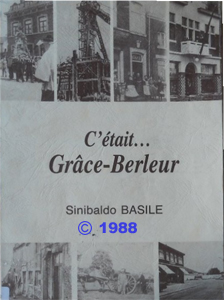
|
The following photos have been received from more than one source. They are from the book (pictured at left) "C'était Grace Berleur" by Sinibaldo Basile, 1988;
Page 76 – Photo 4. Avion abattu tombé à Loncin. (Photo collection S. BASILE).
The book details and scan of photo was sent to me in 2019 by Maxime Noel, a researcher in Belgium.
Max told me that Mr BASILE died in July 2013.
From the Internet, BASILE was born in 1944 – so he was
only about one year old when that aircraft crashed near Loncin.
Also – from the internet – “Sinibaldo Basile (1944-2013), trained teacher and local historian,
author of numerous books on Grace-Berleur. A school in the town bears his name.”
The book may have been "self published" by BASILE, and appears to be out-of-print, however it would still be covered by Copyright. The photo from his personal collection would probably be out of Copyright (assumed to be dated 15 April 1945). I have unsuccessfully tried to locate a source for permission to re-publish on this website. If a reader can assist, please make contact and I will amend this page.
The second image of Halifax PN427 was received from several people, their original source unknown, and possibly a copy of a copy. (Thanks John D, and Duke, and others.) |
The scan of the original page below clearly shows the Halifax Serial Number PN427/G, as well as the Squadron aircraft code Z5-A. The /G added to the Serial Number indicates that it requires an armed Guard when not in use, as it carries items of equipment relating to the 100 Group Special Duties. The A in the Z5-A appears slightly different to the Z5, and may relate to its recent arrival at 462 Squadron, and allocation of code A. The usual 3 broad vertical yellow stripes on the tail fins, which would also identify it as 462 squadron, had not yet been added, also indicating its newness. Two large ABC aerials can be seen – one in front of, and one behind the Housing for the Direction Finding Loop on the upper fuselage. A Belgian woman can be seen on the ground beside where the port wing has sheared off; and two persons are in the mid-upper turret, and another at the top of the broken fuselage. As the crew's 8 parachutes had not been used, and were missing on their return from medical and other checks, it was highly likely that they were removed by these or other sight-seers. The second lesser-quality image with caption and page number, shows more detail of the people.
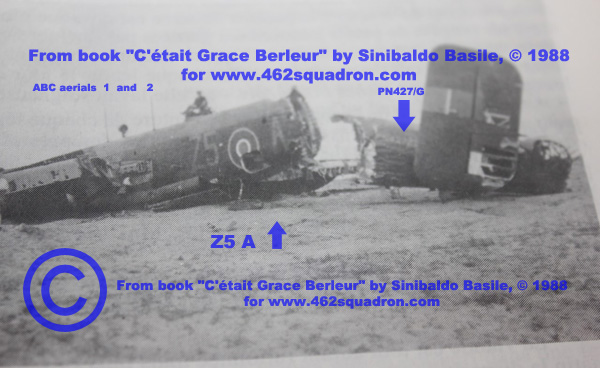
Below is a lesser-quality copy of the same photo, but including original caption and page details
"Photo 4. Avion abattu tombé à Loncin. (Photo collection S. BASILE) Page 76"
This translates as "A plane crashed in Loncin" Loncin (a village near Liège).
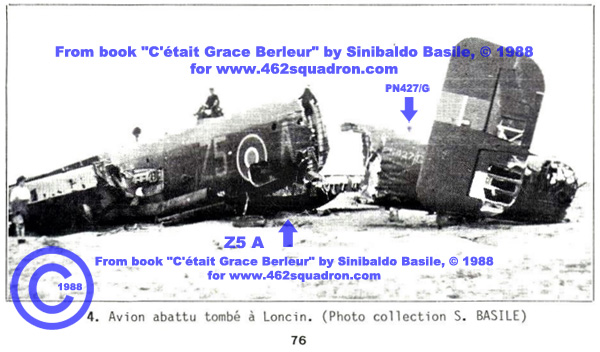
The following was written by Sgt. Flight Engineer A.A. ("Duke") Newstead (published on 462squadron.com website 06 May 2022)
This is the story of the end of the short life of Halifax III A-Able, PN427 of 462 RAAF
Squadron which crashed irreparably on 15th April 1945 while
carrying out only its second bombing operation.
Photo above: Avion abattu tombé à Loncin.
This is the remains of 462 Squadron’s Halifax, Z5 A-Able PN427
The people using the wreckage as a playground are Belgium civilians. The location is a
USAAF “perforated metal on grass fighter landing strip” some 6 miles from Liege, Belgium.
The date is 15th April 1945.
Although everyone survived this crash I am now the only one alive to tell the story, but this
story is not just mine, it is the crew’s. I am merely writing it down, although I have freely
used notes written by the late George Hicks our navigator, and the late Ken (KJ) Faithful our
Bomb Aimer.
….............................................
The day before this photograph was taken our Squadron was ordered to deploy 12 aircraft to
mount a spoof raid on Jüterbog, 8 to drop Window and 4 others, ABC equipped, to attack
the same target while jamming the enemy's ground radio instructions to their airborne
fighters, with our ABC equipment, which was installed in the port side of the crash position.
ABC aircraft carried an extra crewman, an RCAF German speaker who would listen to the
babble of German, Polish, Romanian and Czech voices, identify the German fighter
Controller and jam his transmission. Our aircraft was ABC equipped and our German speaker
was Sgt Reinke. Our designated route to our target meant a round trip of about 2000 miles so
we carried extra fuel in an overload tank carried in the belly bomb bay, with our token bomb
load of two 500 lbs bombs in the wing bays.
Our job today was to support a Main Force of 500 plus aircraft, mainly Lancaster's, attacking
the railway facilities and barracks at Potsdam about 40 miles from our target. This would be
the last major heavy bomber raid of the war.
Briefing, meal, all went as normal, slight hitch when I realised that my lucky white scarf
bought for me by my then schoolgirl sister was not in my locker so I'd have to fly without it
but I still had my tatty rabbits foot!
We took off at 18.35 and set course, our Squadron joining in with Main Bomber Stream. We
flew on, routine stuff, when enough fuel had been used from wing tanks 1 & 3 I pumped the
contents of our belly tank into them, checking that nitrogen was pumped into the now empty
tank. The use of the inert gas was experimental and we often had malfunctions but but it
seems to be working well on our aircraft,
which, Ken wrote, was only on its second Operation.
We droned on through the night until at a predetermined location we parted company with
Main stream; we had not flown far on our new course when we ran into quite heavy localised
flak, the often underrated weapon in the enemy arsenal. We flew clear as fast as we had
flown into it, thanked our lucky stars and pressed on.
But not for long. Without warning one of our port engines failed. Its prop began windmilling,
which made it difficult for the pilot and could cause further damage to the engine so it was
quickly feathered.
Ken wrote: ”On reaching target I think we were below the briefed height of 18,000 feet but I
cannot confirm that.... releasing the bombs was no problem, but as the bomb doors closed the
other port engine failed” ........... and that too was promptly feathered.
We set course for home but in spite of the Skipper's efforts, and he was a very good pilot, we
were losing height at an alarming rate, although theoretically we should have managed to
maintain height. My concern was the two starboard engines, the Skipper was at times running
them on full throttle and if they malfunctioned then we would be in real trouble, but
thankfully they seemed to be coping very well.
Back to Ken: “Skip thought we would not make base or even the UK and our height at the
German border was just over 3000 feet.” ........... This means we had lost some 14/15000 feet over
about 300 miles flying. We discussed options, baling out or heading for the Channel and
ditching were ruled out, but our navigator George saved us by saying that he thought that
there was a USAAF temporary fighter strip near Liege where we could land, but he needed a
fix and wanted a generator put back on line to do this.
I unfeatherd one of the engines, it ran a bit rough but it did not take George long to get his
fix, he really was a first class navigator, but I had trouble in re-feathering the engine
again. But eventually the prop stopped windmilling as we headed for the airstrip.
The strip, about six miles from Liege, was made by laying interlocking perforated metal
strips on a previously bulldozed flat piece of ground and the landing lights were Goosenecks,
a device like a watering can, filled with paraffin with a lighted wick. We could not make R/T
contact so I fired off the colours of the day as Skip ordered us all to get into the crash
positions between the two wing spars.
But Mid-upper Gunner Aggy called urgently to say that an aircraft had crashed halfway down
the runway and was on fire. Skip called to say he was going to go round again and Aggy kept
up a running commentary as the Skipper opened the throttles and commenced flying a long
loop to keep the runway in sight while lining up the aircraft for another attempted landing.
Very fine flying from our Skipper.
Aggy called up to say they were bulldozing the aircraft, which he identified as a Liberator, off
the runway so we could attempt a landing. As the skipper lined up the aircraft for a second
attempted landing he asked me to fire off some “Reds “ to ensure that the runway was clear. I
had checked, for the second or third time, that the nitrogen was turned on and made sure that
the overload tank really was empty by switching on the transfer pump again, but we were all
aware that we had about 300 gallons of fuel still in the self sealing wing tanks, so with my
battledress blouse full of first aid kits I moved back to the crash position.
Although one side of the crash position was occupied by the ABC equipment there was still
ample room for me to sit on the floor or on the seat opposite but I didn't. I sat on the front
spar and held onto the diagonal braces. Why I chose this option I'll never know, I can only
assume that I did not expect the landing to be so severe which was a rather stupid assumption.
But I survived it and more importantly it did not harm any other crew members.
Ken wrote: “We hit first at an angle to the strip and became airborne momentarily, I
remember
thinking 'this isn't too bad', but then we crashed very heavily into something like a ploughed
field. The aircraft broke in two midships and left one wing and one of the engines back down
the runway. There was a lot of dust and stuff flying about at first thought to be smoke but
miraculously there was no fire.”
The time was 01.15.
I found myself very dazed, lying on my back with my head level with Skip's feet, having
slithered about 6 feet from my seat on the forward main spar. My first memory is of the
silence and then dust everywhere which for one panicky moment I thought was smoke, then
to my surprise I saw that the pilot's instrument panel was still lit up and I could see Andy
slumped over the control column but he was still breathing. I also realised that I was not
injured and then the moment I will never forget; a figure came from the rear of the aircraft
through the rapidly diminishing dust and a voice which I recognised asked if we were alright.
It was Ken Faithful our bomb Aimer and he grabbed my arm and hauled me to my feet.
Ken released Andy's seat belt and we both pushed him up to the opened escape hatch where
willing crew members pulled him out and three or four of them carried him away from the
potentially dangerous aircraft and we others followed. There was no panic. Best described as
an orderly scramble.
We all sat, Andy thankfully beginning to recover, well clear of the stricken aircraft, until a GI
found us and handed over large pack of Lucky Strike cigarettes, drove us to their Flight Hut
where we all enjoyed cups of coffee while Andy was seen by a doctor. The Americans were
able to make radio contact with Foulsham, with assistance from George and Dinger, so that
we were never posted as “Missing” which was a great relief to us all. The USAAF Liberator
crew were also there some nursing broken limbs but no signs of any burns.
We are unanimous in recording that we were taken to an empty girls school where we spent
the night or what was left of it on hard narrow divans separated only by modesty boards.
None of us seem to recall having breakfast although I'm sure that our Allies fed us and then
we were taken to see the remains of our aircraft. Thankfully Andy seemed to have recovered
completely from his ordeal. In the aircraft we found that everything not nailed down had been
taken, presumably by the civilians in the photograph. I do not think any of us lost much
personal stuff.
Ken writes that he cannot recall anything from now on, and George has little to say but I have
some clear but disconnected memories. The Americans had brought us back to Liege and
walking along one of its main streets we met two RAF non-aircrew Squadron
Leaders, whether by chance or whether the Americans had notified them of our presence I
know not. The RAF officers were in Belgium in connection with the Nazi's use of rocket/jet
propulsion aircraft. That is all we were told. But they did offer us accommodation, far
superior to the Girls School, washing and shaving facilities and excellent food most probably
supplied by our American Allies. And they gave or loaned Andy some money because we
would not be carrying money on an Operation.
Indeed my last memory of our brief sojourn in Liege is of eight of us sitting in the sun outside
a “pub” very much in a holiday mood drinking lager and trying out our schoolboy French on
some of the locals. This relaxed mood stayed with us when we were flown back to Foulsham
next day and we thought it hilarious that the USAAF parachutes supplied to replace those
stolen from our crashed aircraft did not fit RAF harness.
We were able to thank out RAF hosts but not the USAAF personnel who had looked
after us after our crash and ferried us about later, so belatedly – Thanks Yanks.
And Thank you – Sgt Flight Engineer A. A. NEWSTEAD ("Duke") for recording this story and for giving permission for publication here.
The photo from Belgium absolutely clears up the incorrect identification of this Halifax, by various Authors. The Serial Number visible on the fuselage, is not debatable. F/Eng Newstead has tried for years to have the error corrected – he was there, and his Log-book details match.
The 462 Squadron ORB has errors – recording the Serial Numbers of previously "lost" or damaged aircraft, instead of the replacement Halifax aircraft allocated the same Z5-A code. The erroneous Serial Number was probably due to the quick sequence of aircraft which were allocated to 462 Squadron, each to replace a recent loss, with the resultant paperwork apparently not keeping pace.
Official records are not always accurate, as has been found for the names and Service Numbers of various personnel from 462 Squadron. But – there was a War on.
Below is a summary of the 462 Squadron Halifax aircraft which used Z5-A – Able.
| Serial |
Code |
First Op |
Last Op |
Notes |
| LL598 |
Z5-A |
25/08/1944 |
14/01/1945 |
Caught fire, crashed near Shipdham soon after take-off;
ASTILL, Crew 52, 6 KIA, 2 injured; Cat E write-off, FB; SOC 19/01/1945 |
| MZ447 |
Z5-A |
28/01/1945 |
24/02/1945 |
Failed to return from Ruhr; RATE, Crew 13, 7 KIA, 1 PoW;
Cat E, Missing, FB; SOC 01/03/1945 |
| RG432 |
Z5-A |
02/04/1945 |
04/04/1945 |
Early return on 3-eng; overshot runway on landing; O'SULLIVAN, Crew 43
(also recorded in error as LG432); Cat B, FB; re-categorised as Cat E, write-off on 13/06/1945; SOC 06/07/1945 |
| PN427 |
Z5-A |
13/04/1945 |
14/04/1945 |
Forced landing on 2-eng, Liege, Belgium, total loss; ANDERSON, Crew 45;
Cat E write-off, FB; SOC 29/04/1945 |
| PN433 |
Z5-A |
22/04/1945 |
24/04/1945 |
To 462 Sqdn on 10 or 15/04/1945; Continued non-operational flying at 462 Sqdn after end of War (up to 27/07/1945?); photos SULLIVAN, Crew 61; and WALKER (Ops usage on 02/04/1945 needs investigation, as it could not have been flown 02/04/1945) |
Dates and losses match Aircraft Movement and Loss Cards – with thanks to Dom Howard who kindly forwarded them.
F B – Flying Battle (Ops);
Cat B – repairable, but not on-site; Cat E – Write-off; SOC – Struck off charge.
Return to top
 to Squadron Crews UK to Squadron Crews UK
|
|
|
|
|
|
|
|
|
|


























